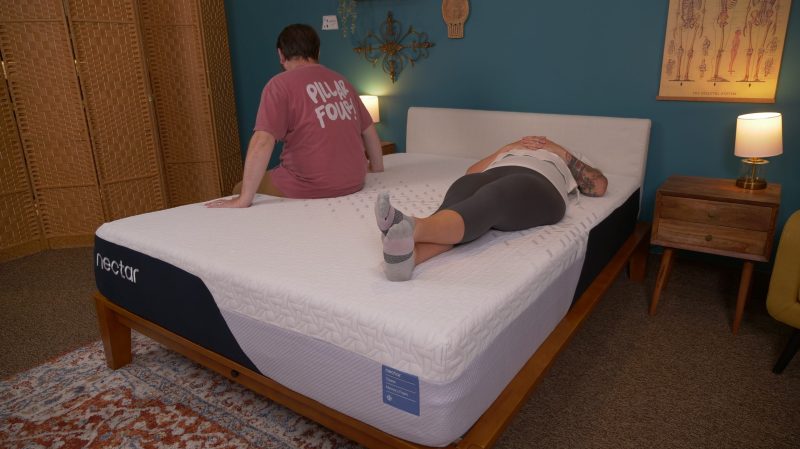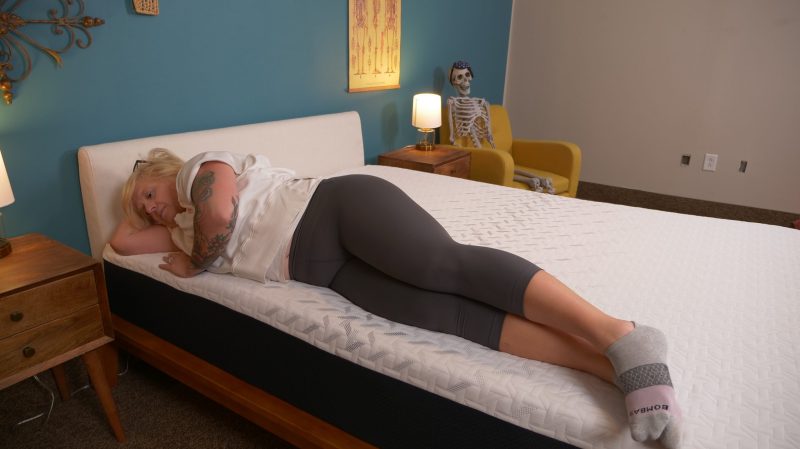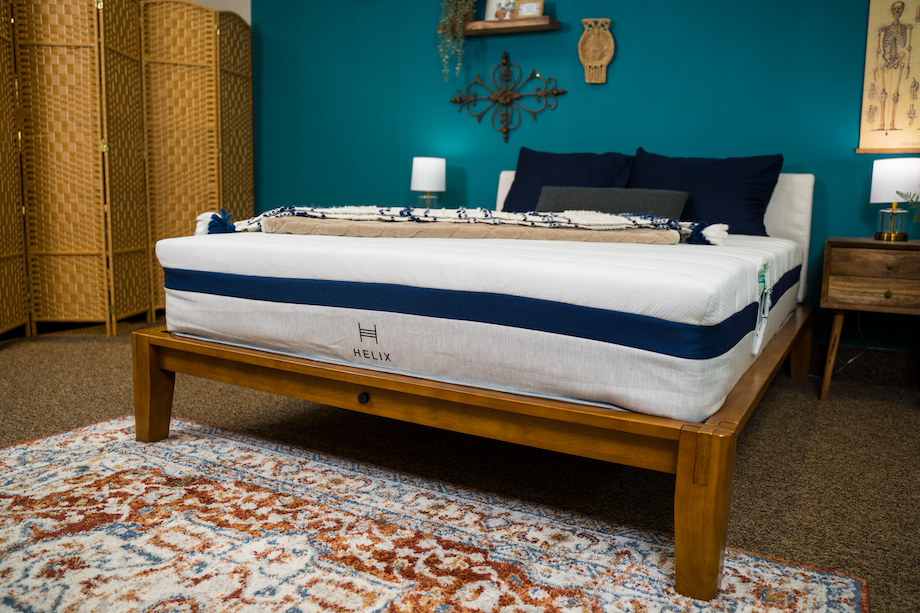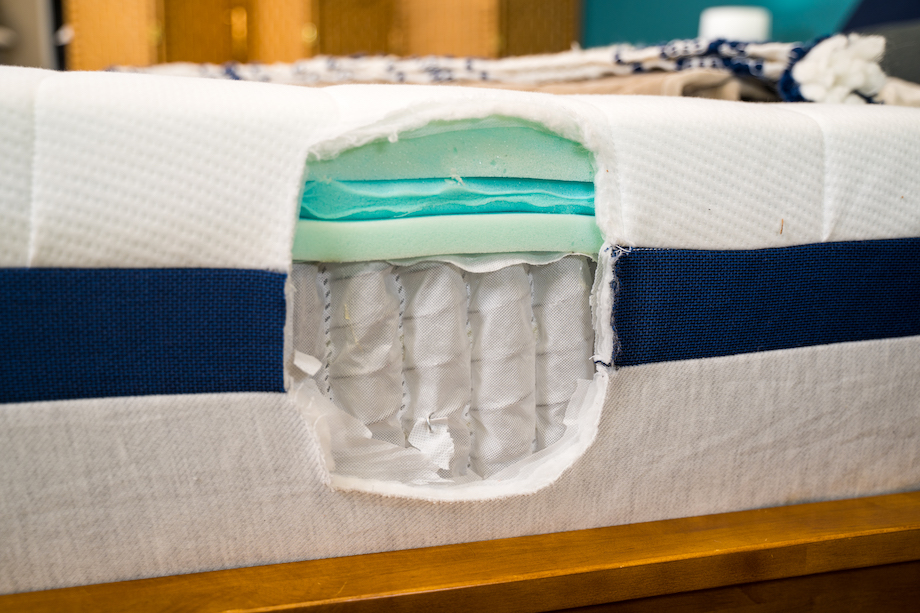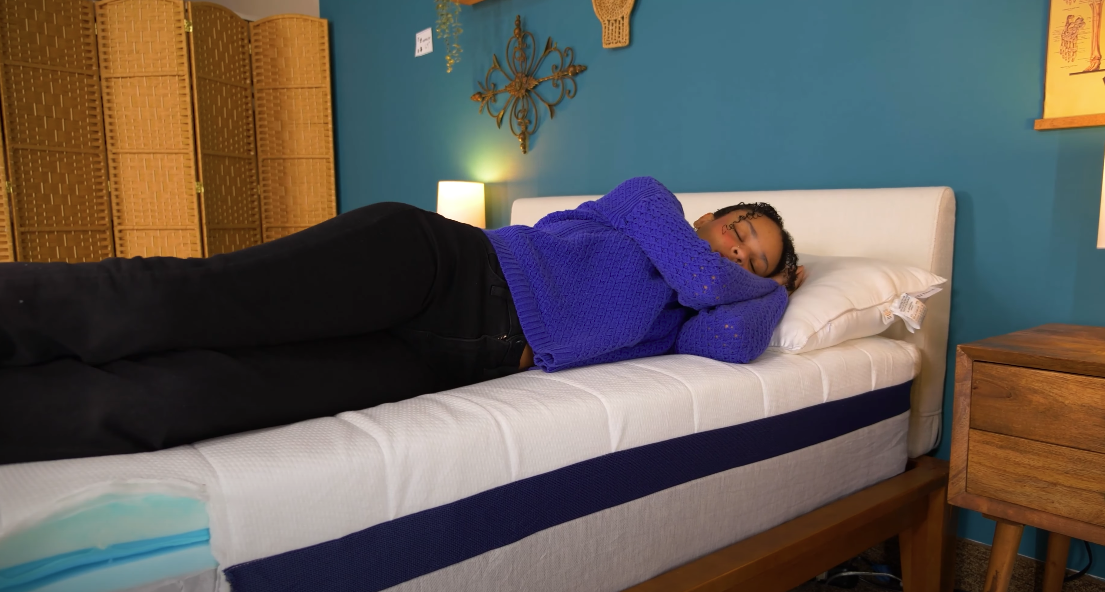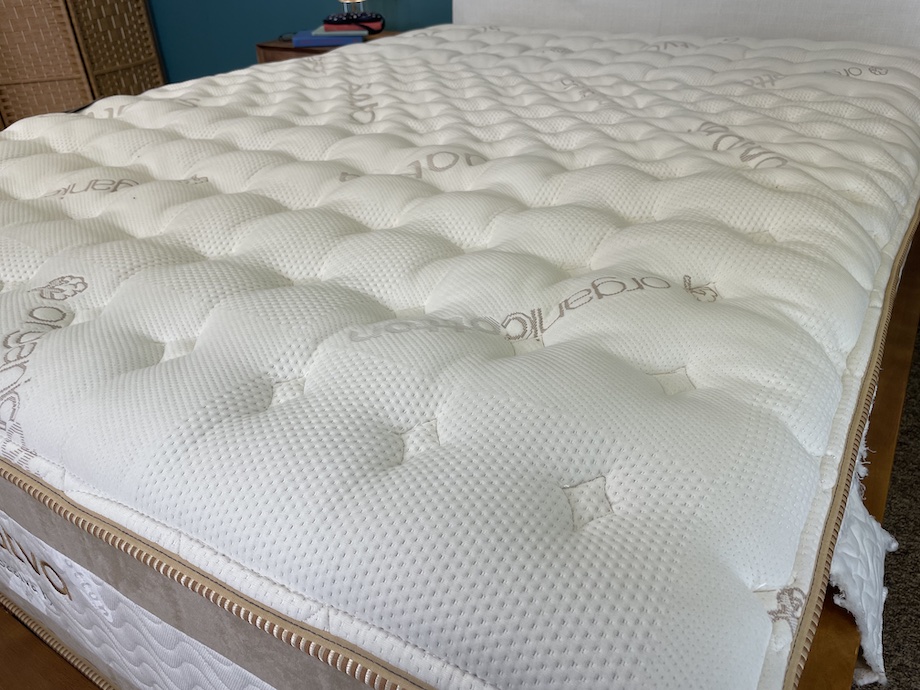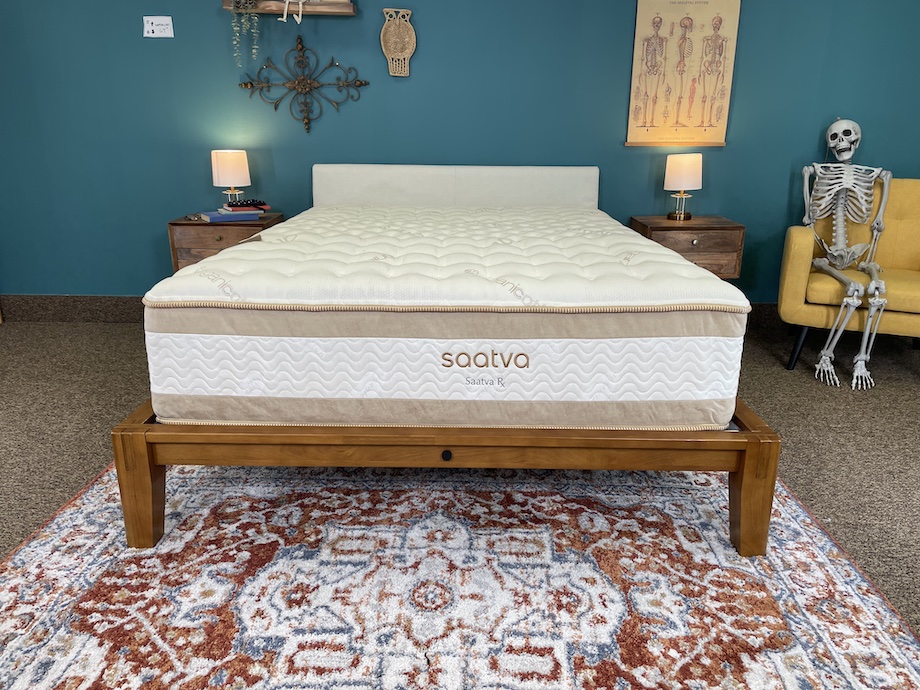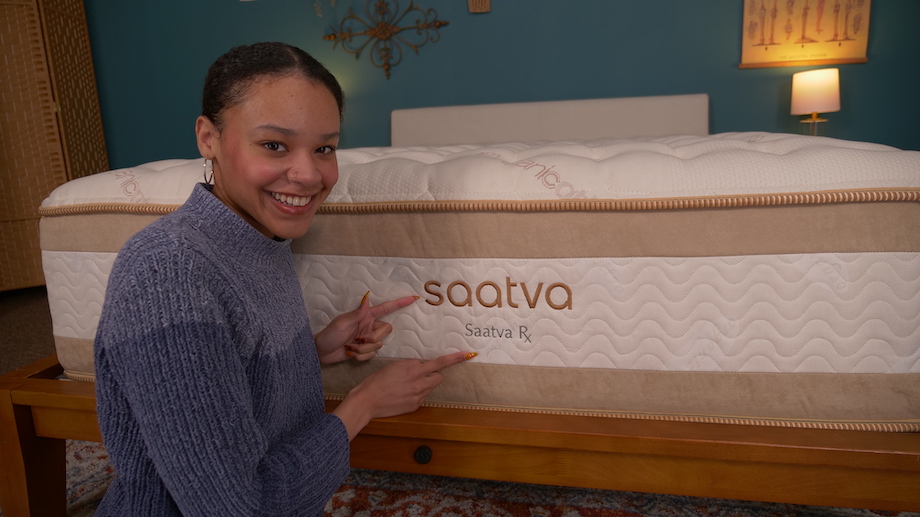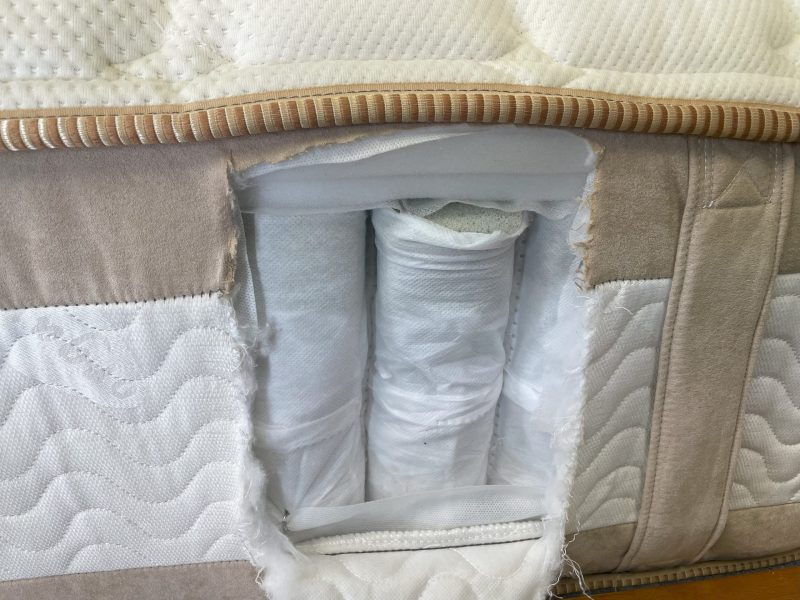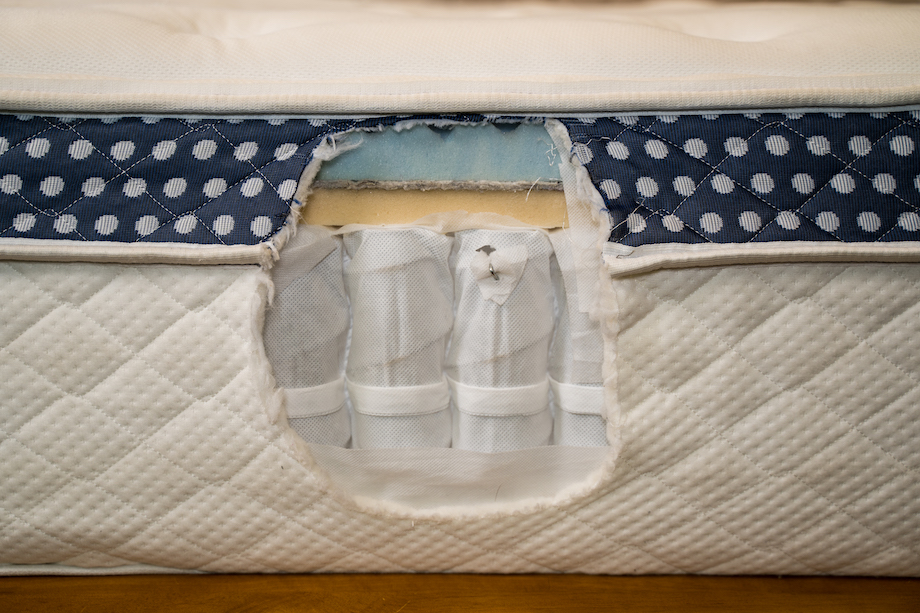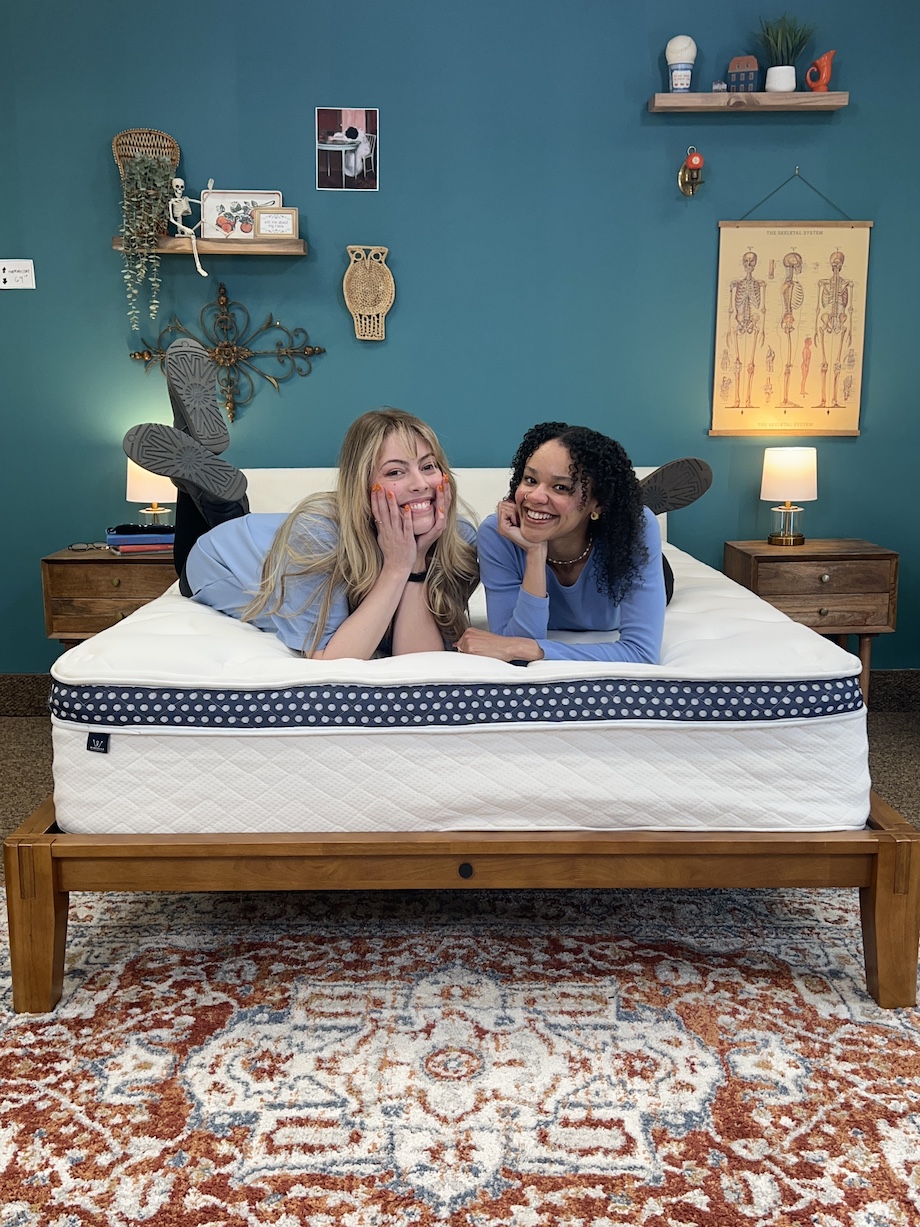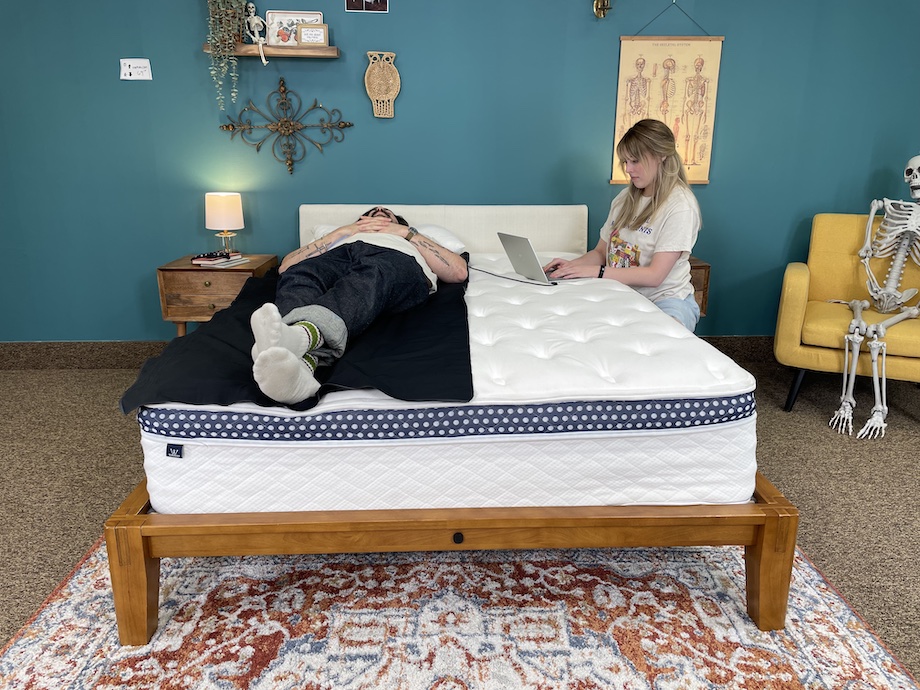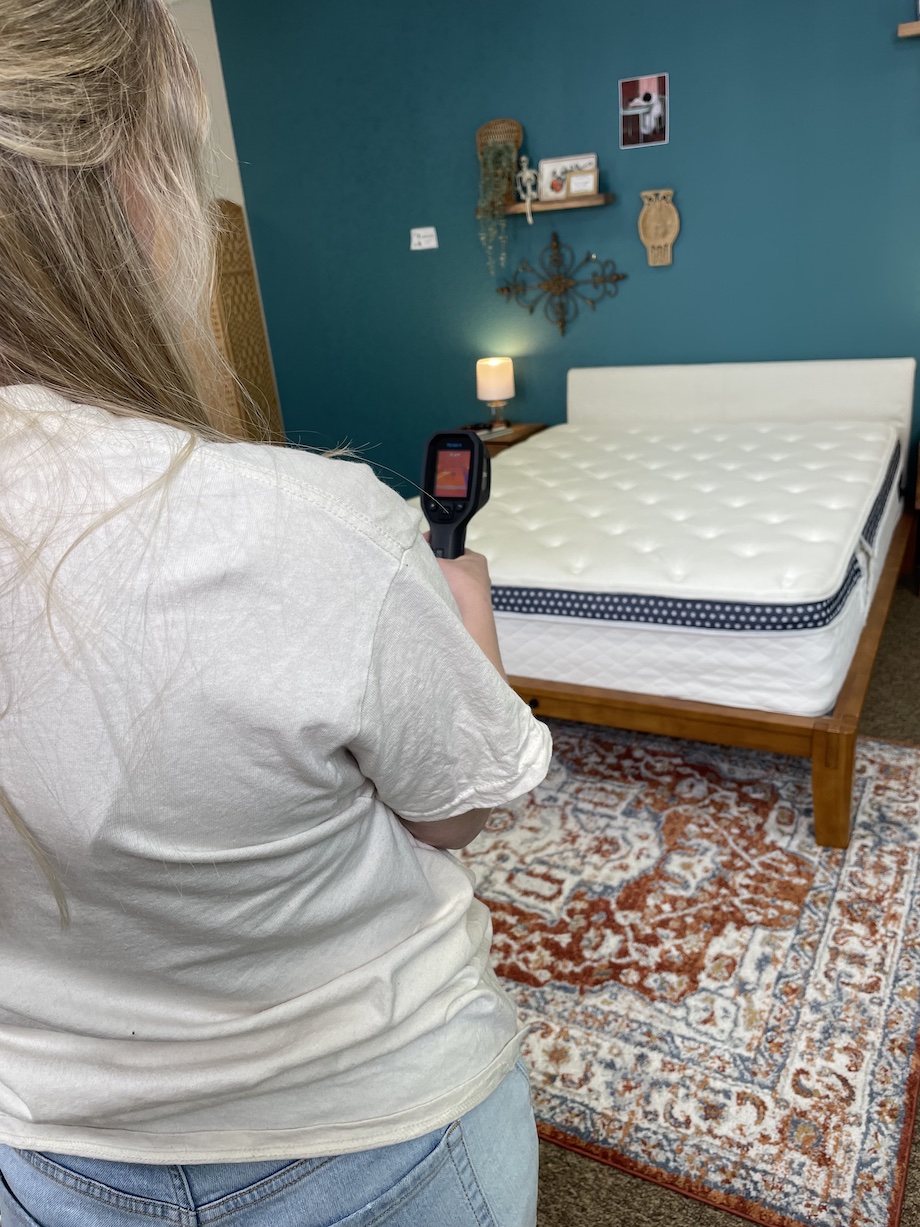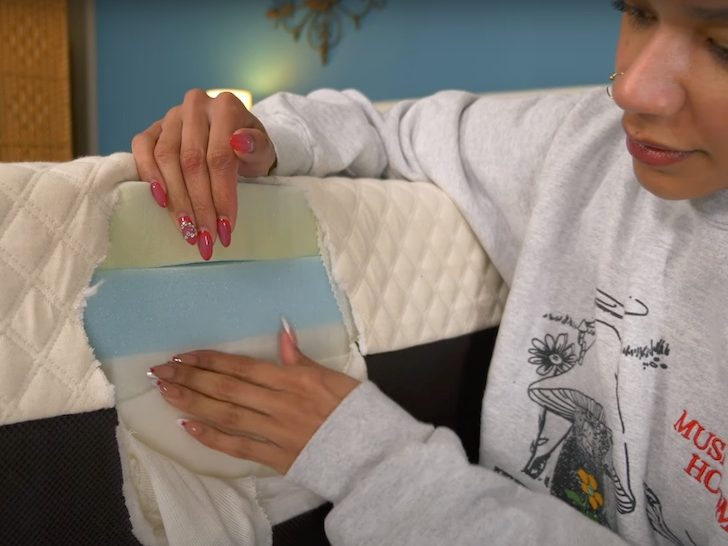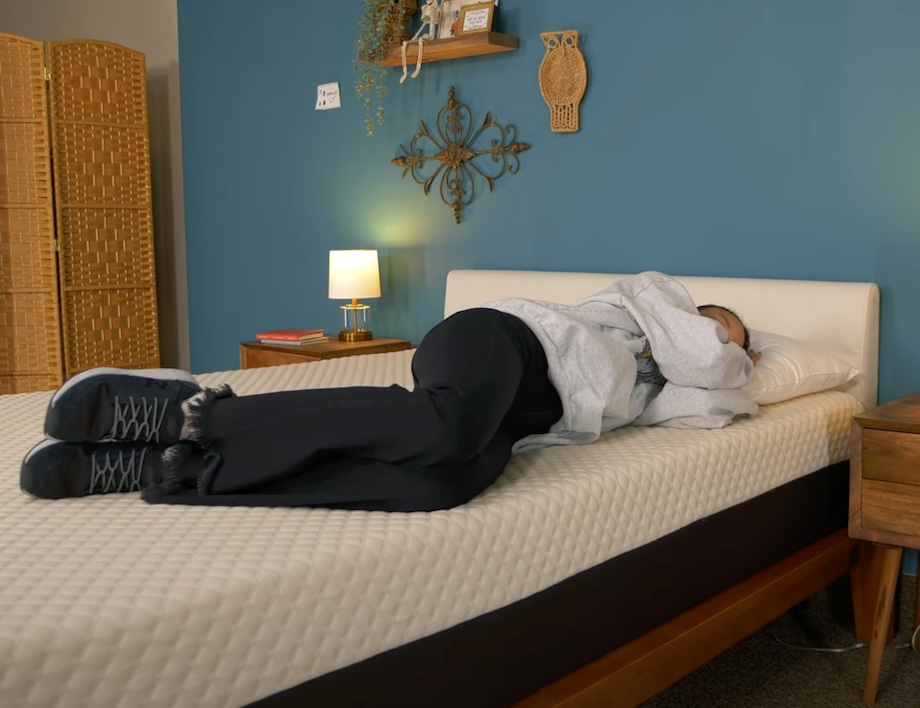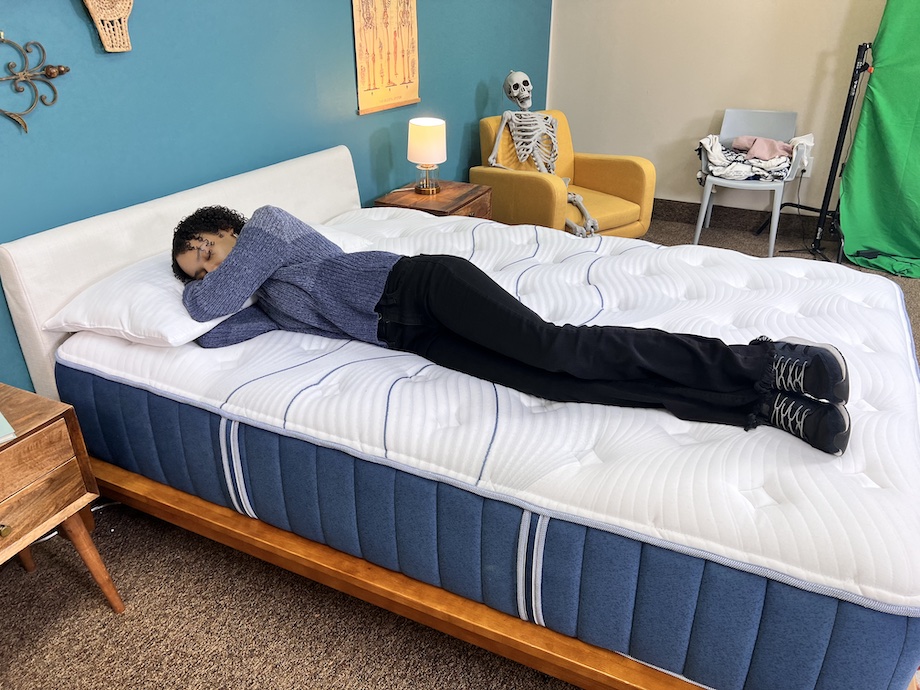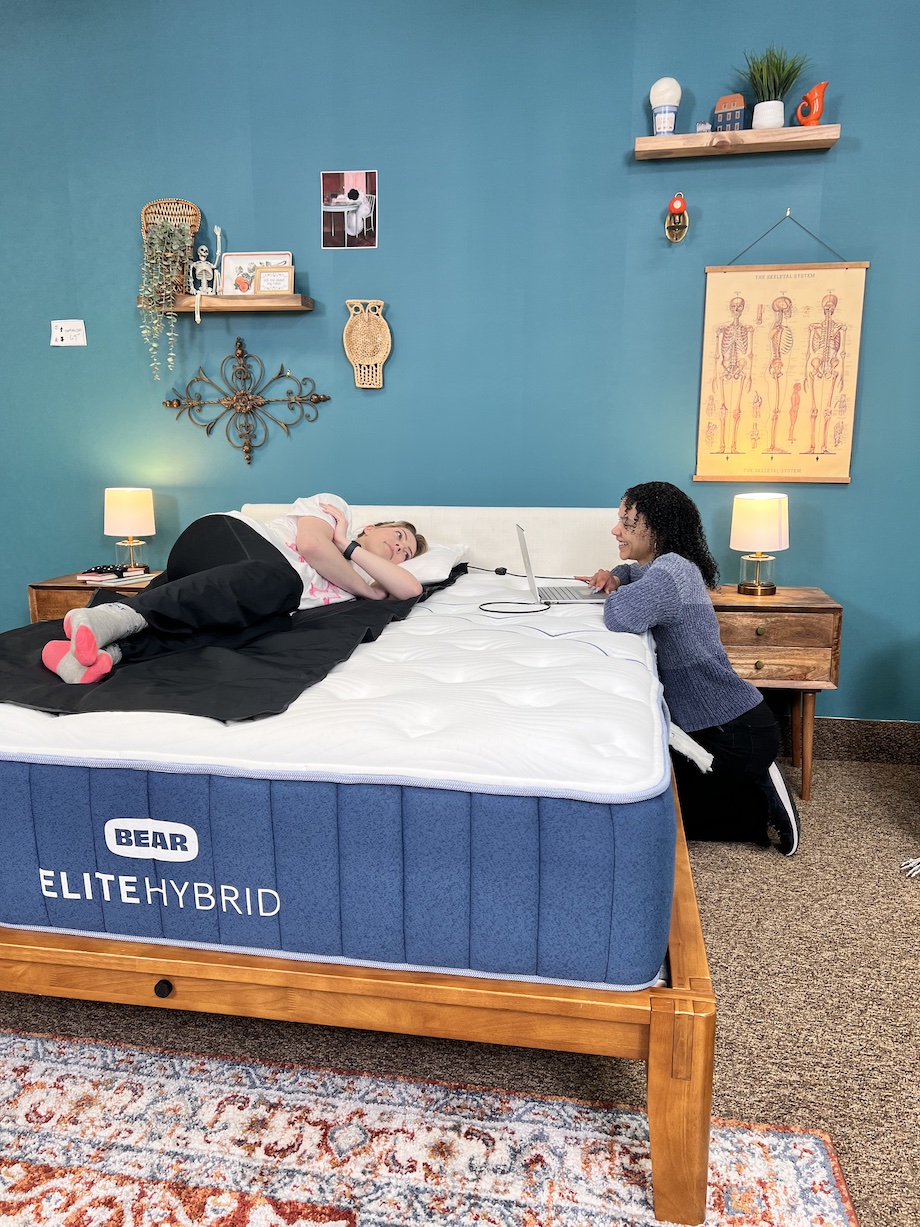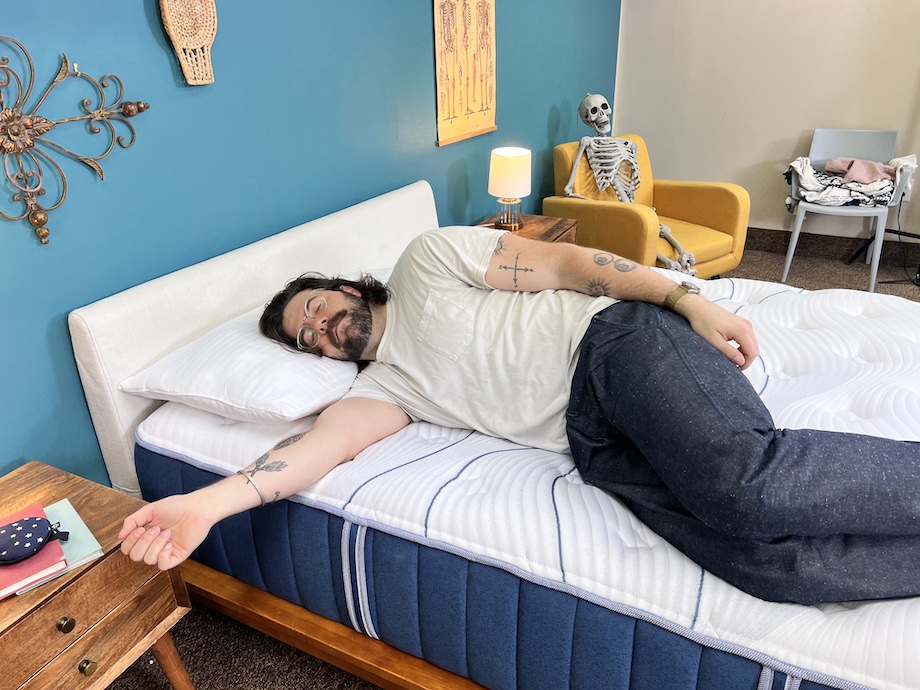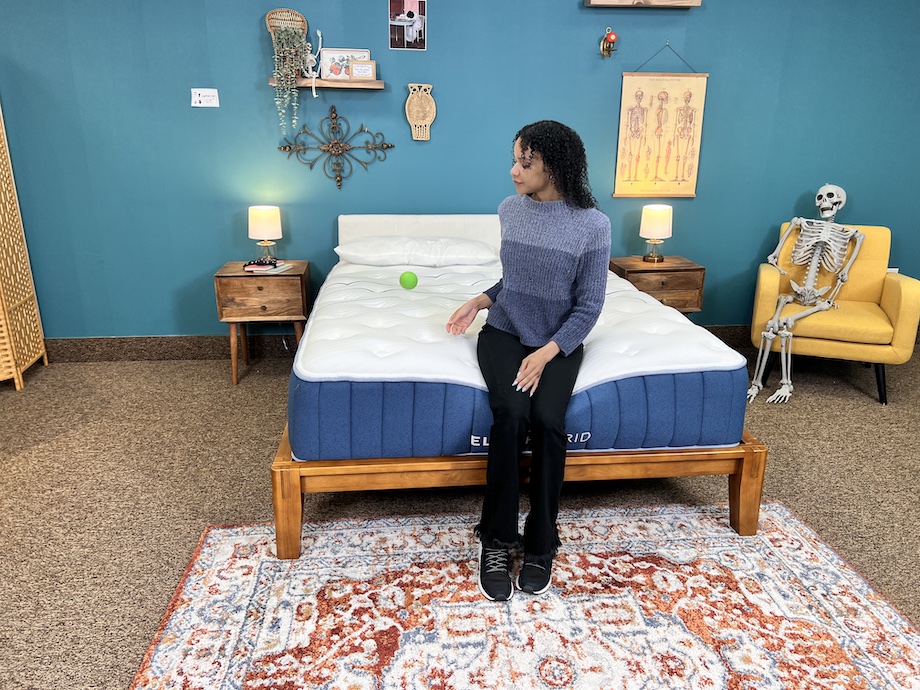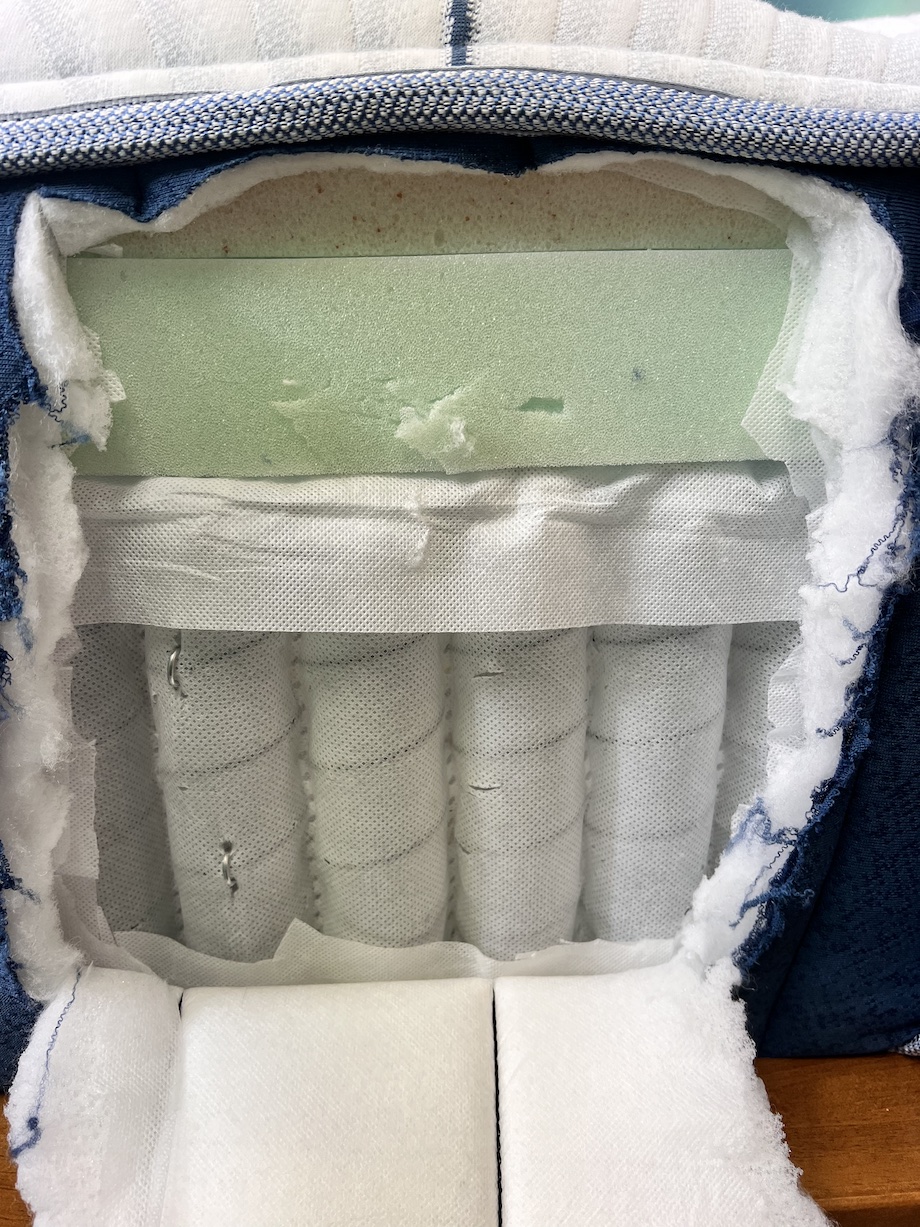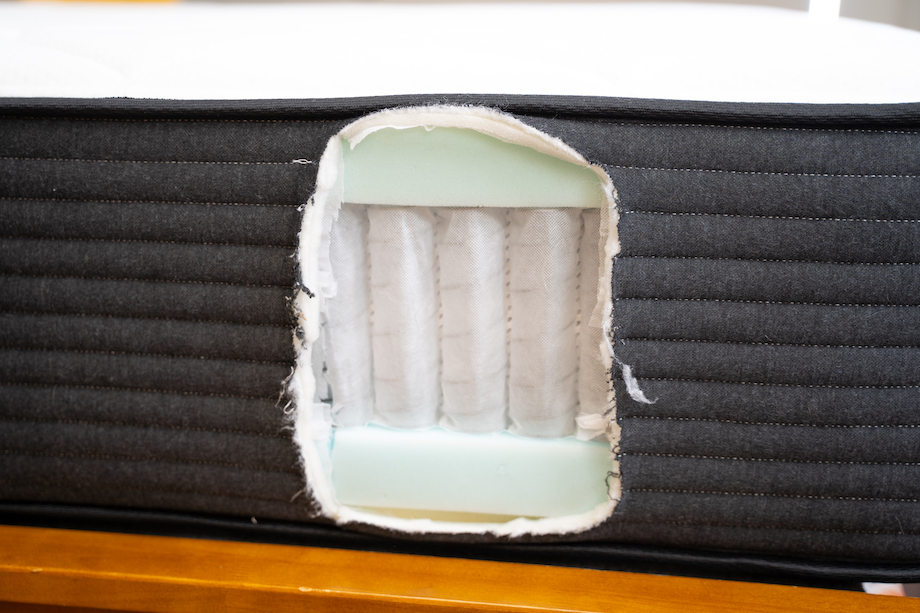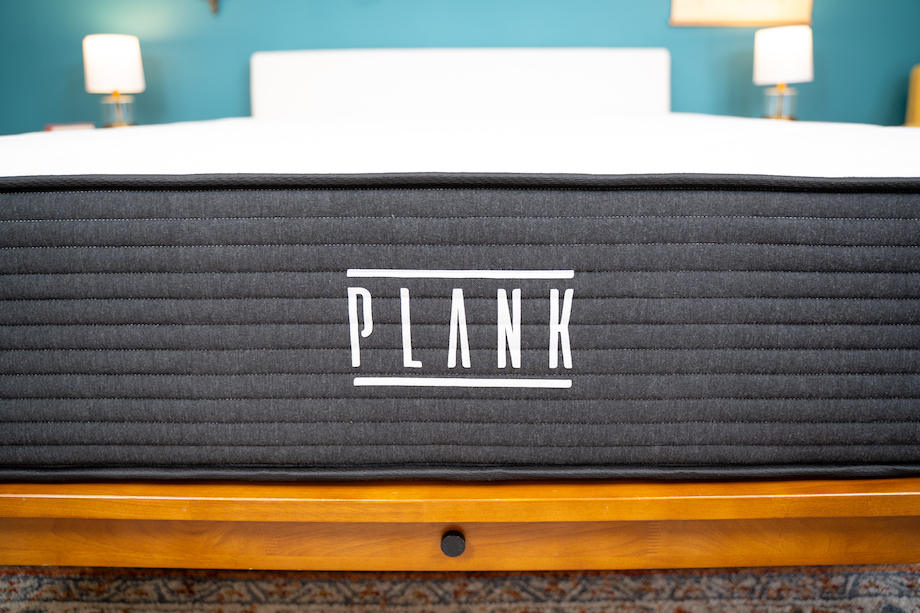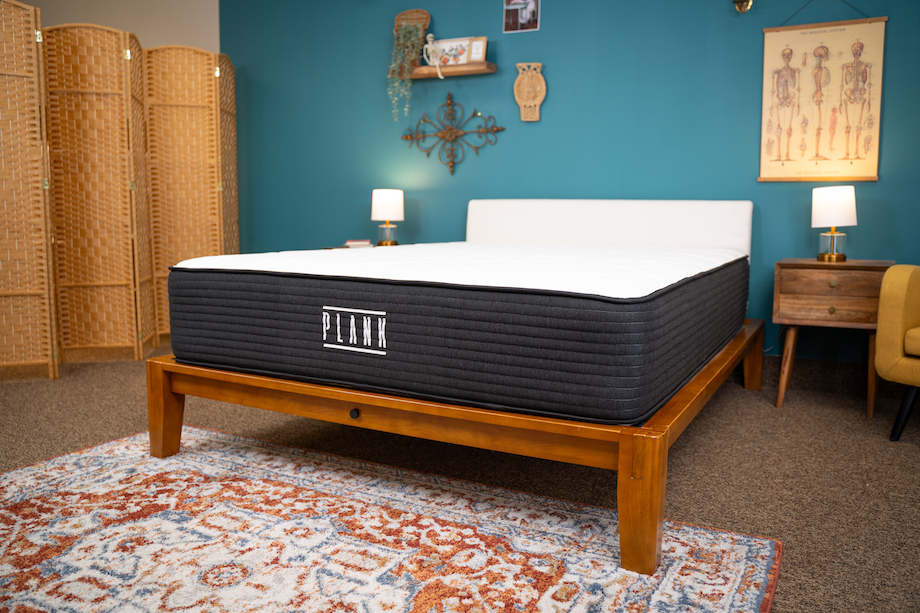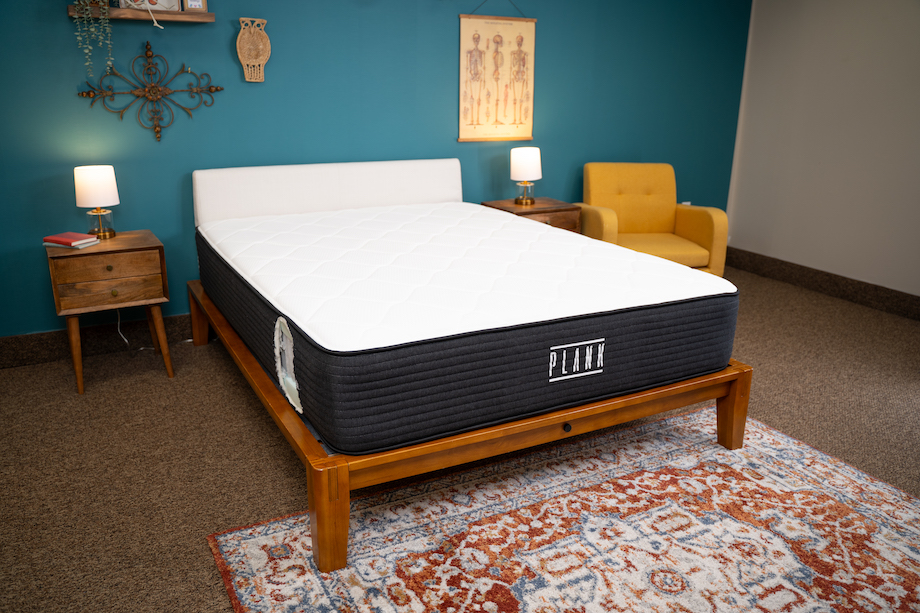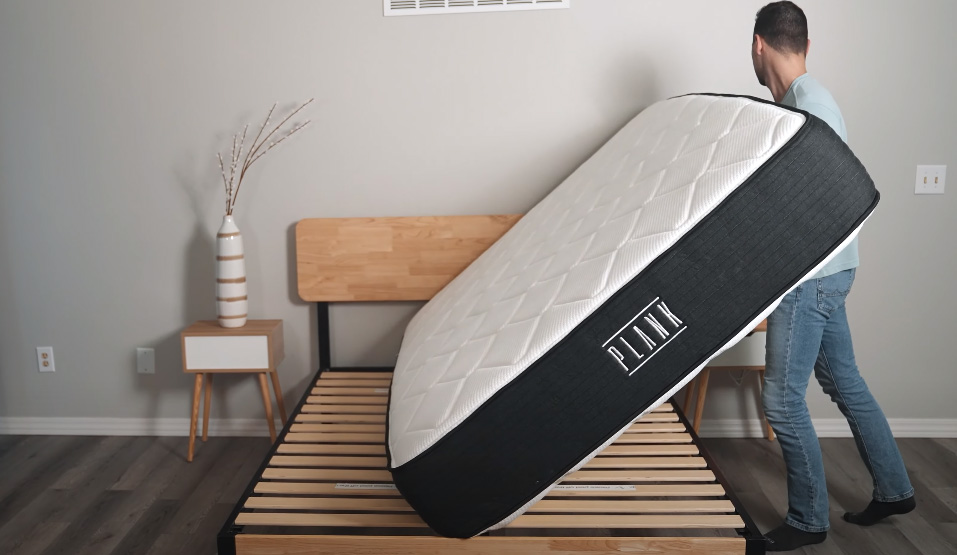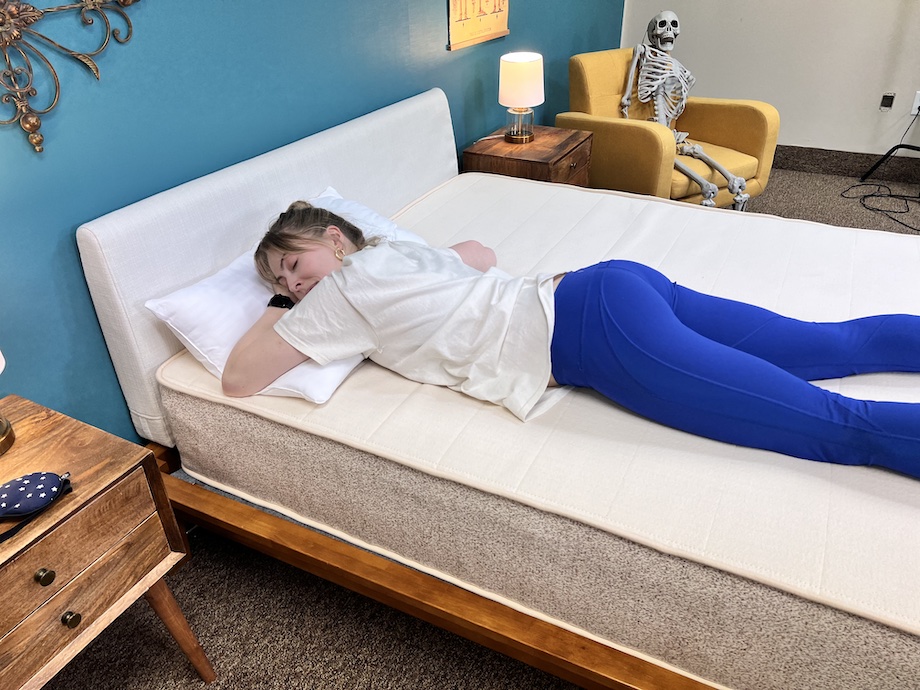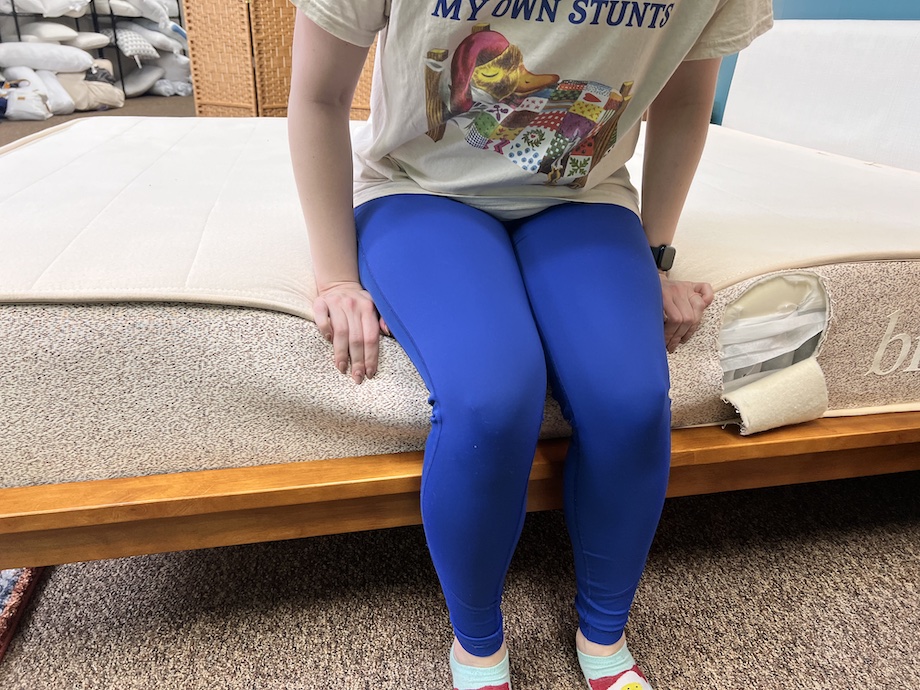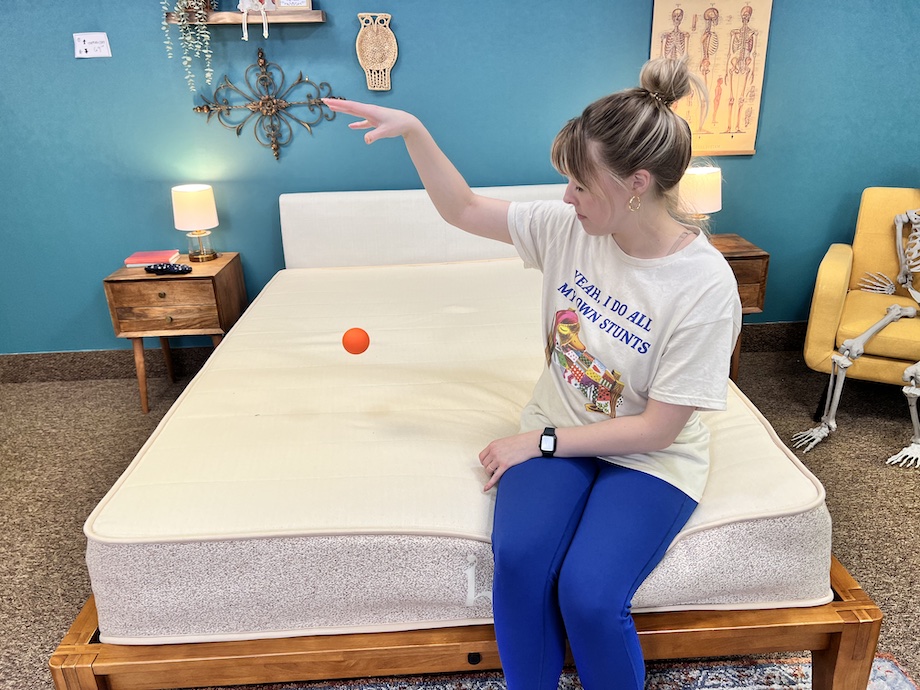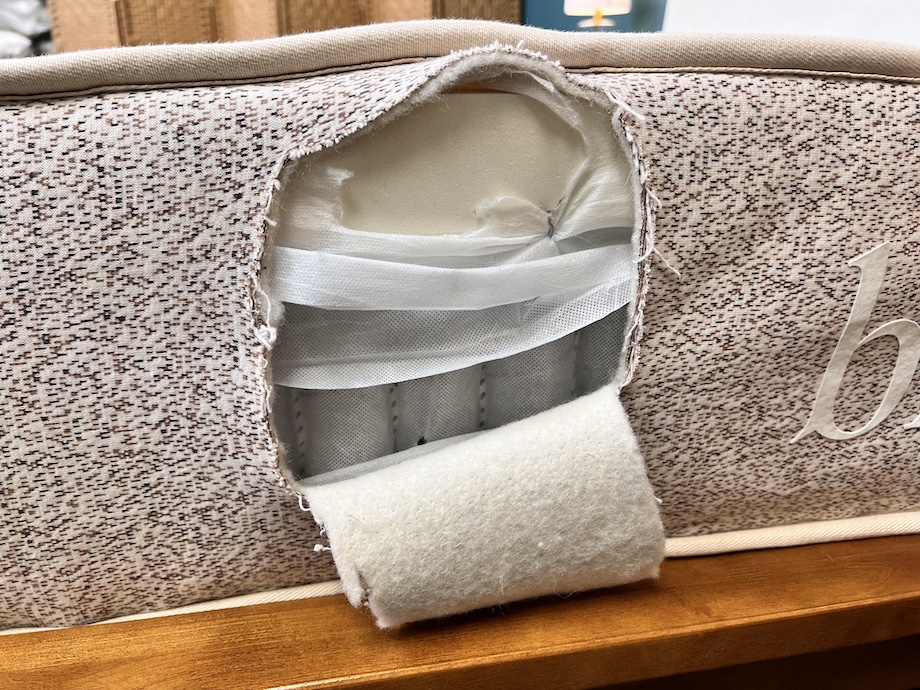Although a herniated disc can be serious, many patients heal from this condition on their own without medical intervention or surgery.1 However, as you might imagine, sleeping on the wrong mattress can prevent your body from healing properly and create a vicious cycle of pain and sleepless nights.
The right mattress could help you rest more easily. In this article, we’ll share our top mattress picks for people with a herniated disc, as well as what you should know when you’re shopping for a mattress and struggling with this condition.
The Saatva Rx tops this list because it was built with two coil layers to minimize back pain. It’s also a supremely versatile mattress that pleases a wider variety of sleepers than many competitors.
Best Mattresses for Herniated Discs
Best Mattresses for Herniated Discs Video Review

Compare The Best Mattresses for Herniated Discs
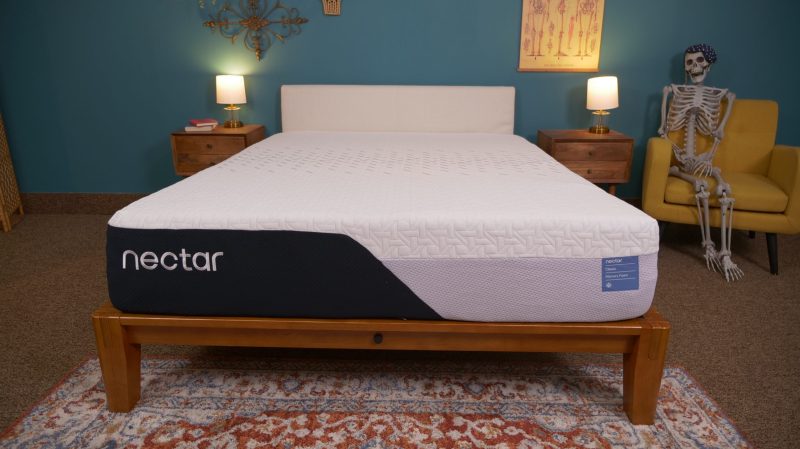
|
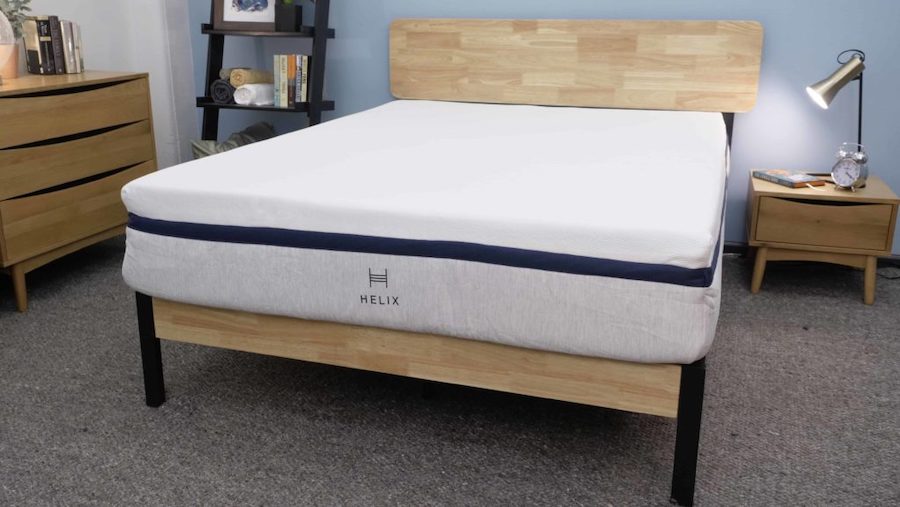
|
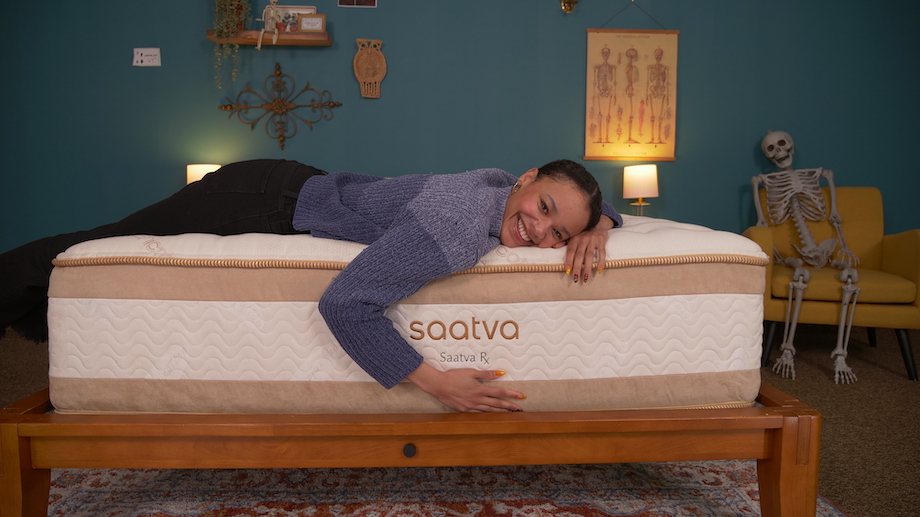
|
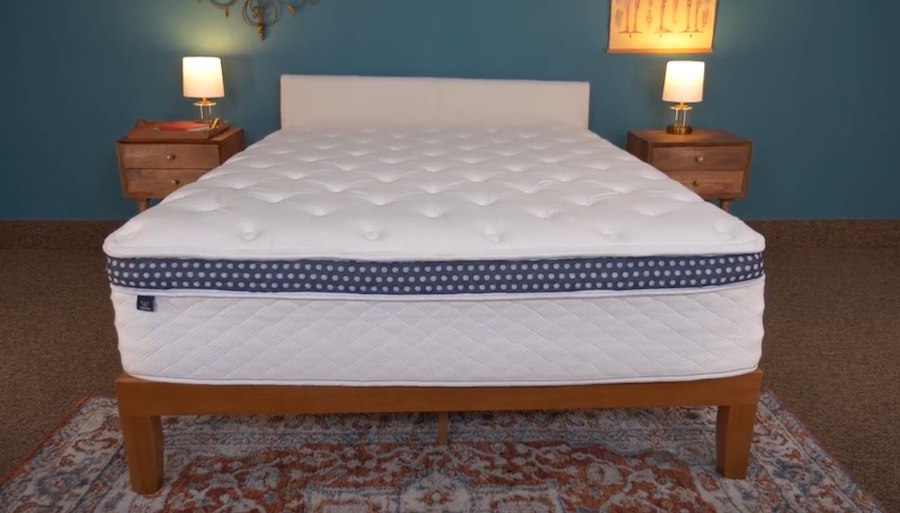
|
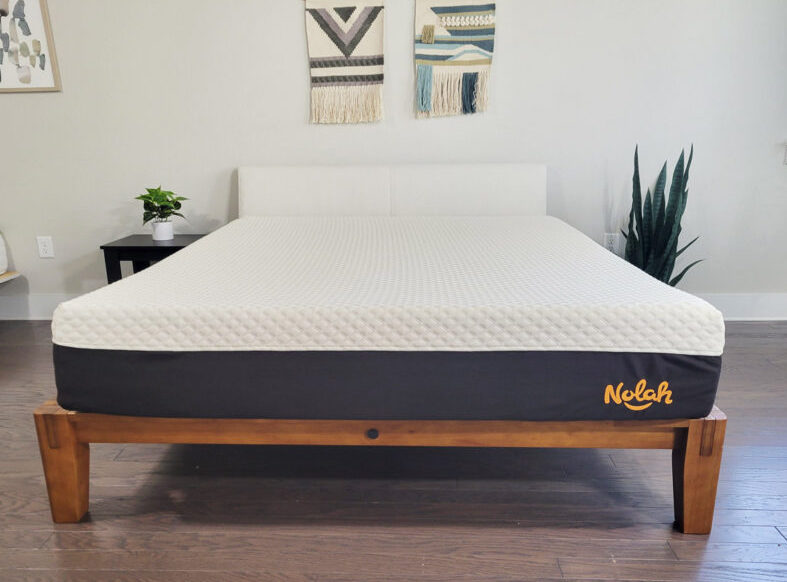
|
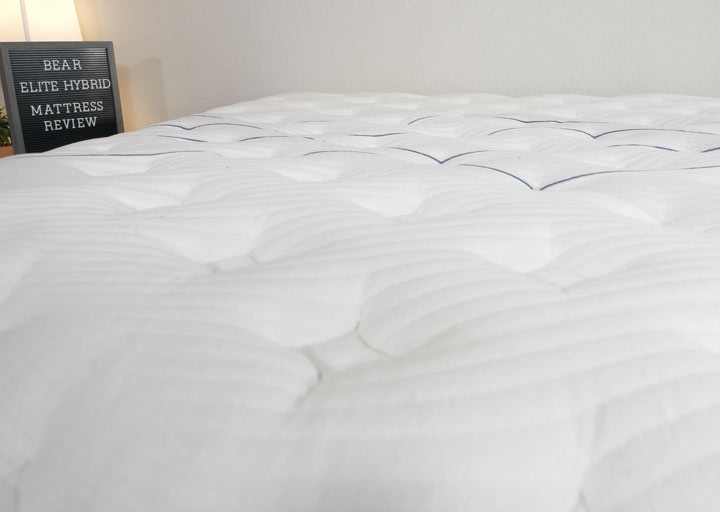
|
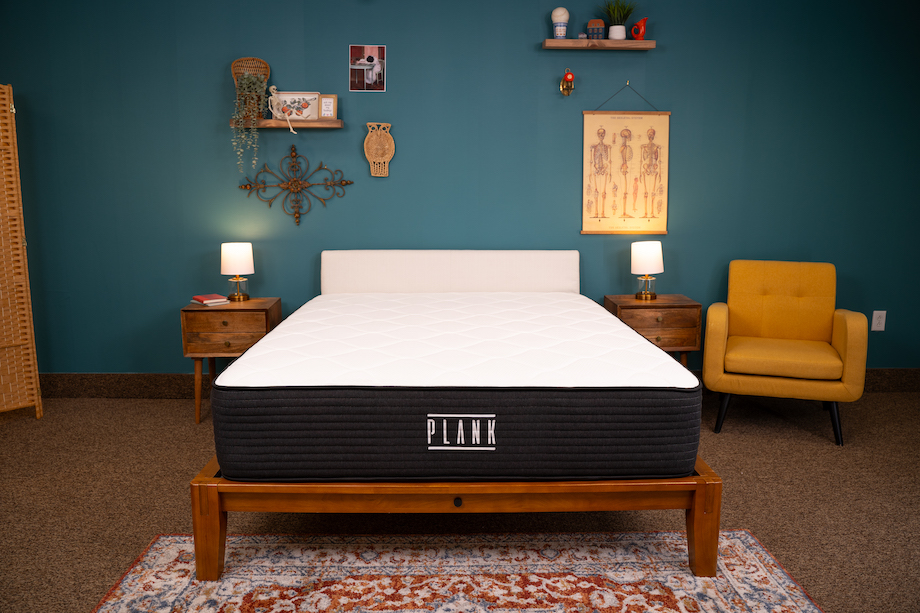
|
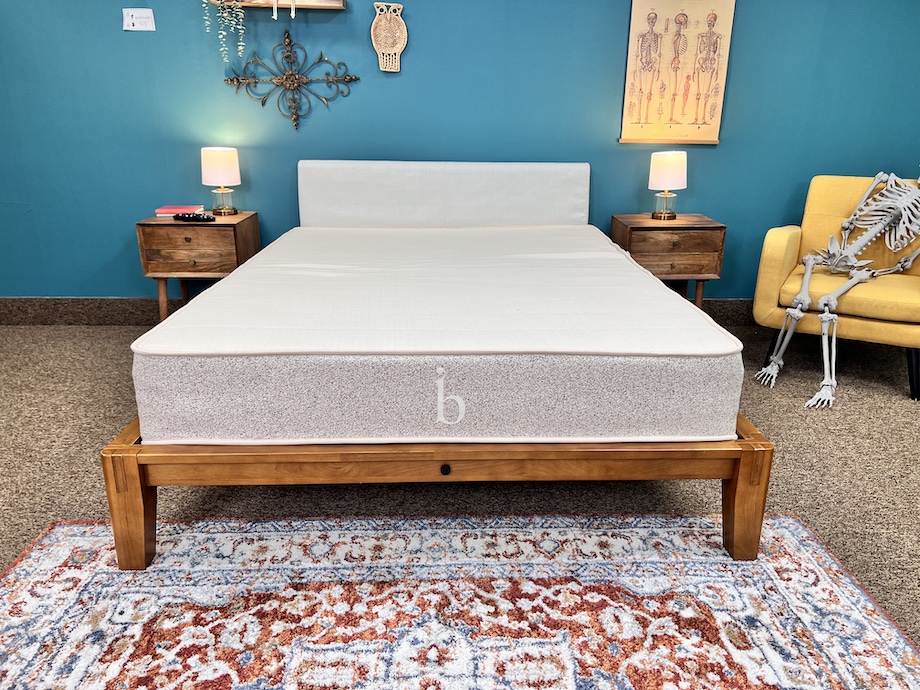
|
|
| Nectar Mattress | Helix Midnight Mattress | Saatva Rx Mattress | WinkBed Mattress | Nolah Signature 12″ Mattress | Bear Elite Hybrid Mattress | Brooklyn Bedding Plank Firm Luxe Mattress | Birch Natural Mattress | |
| Rating | ||||||||
| Firmness | Firm: 7.5/10 | Medium-firm: 6/10 | Medium-firm: 6/10 | Multiple firmness options | Medium-firm: 6/10 | Medium-firm: 6/10 | Multiple firmness options | Medium-firm: 6/10 |
| Material | Foam | Hybrid | Hybrid | Hybrid | Foam | Hybrid | Hybrid | Hybrid |
| Cooling | — | — | — | — | ||||
| Warranty | Lifetime warranty | 10-year warranty | Lifetime warranty | Lifetime warranty | Lifetime warranty | Lifetime Warranty | 10-year warranty | 25-year warranty |
| Shipping | Free shipping | Free shipping | Free white glove delivery | Free shipping | Free shipping | Free shipping | Free shipping minus HI and AK | Free shipping |
| Trial Period | 365 nights | 100 nights | 365 nights | 120 nights | 120 nights | 120 nights | 120 Nights | 100 nights |
| Best For | Back Sleepers, Back Pain, Stomach Sleepers, Side Sleepers, Couples | Couples, Back Sleepers, Side Sleepers | Back Pain, Hip Pain, Stomach Sleepers, Side Sleepers, Back Sleepers, Seniors | Back Sleepers, Stomach Sleepers, Back Pain, Hot Sleepers, Side Sleepers, Hip Pain, Seniors | Side Sleepers, Back Pain | Back Sleepers, Stomach Sleepers, Hot Sleepers, Hip Pain, Seniors | Hot Sleepers, Back Sleepers, Stomach Sleepers, Side Sleepers, Couples | Back Sleepers, Stomach Sleepers, Hot Sleepers, Seniors |
Sleep Advisor’s Testing Methodology
At Sleep Advisor, our mattress reviews are based on findings from in-person tests that allow us to have a genuine understanding of how the mattress feels and performs. We look at features that are valuable to consumers, such as temperature control, bounce, edge support, and motion isolation.
For this roundup, we prioritized features that are especially important for herniated discs. We paid special attention to components such as mattress thickness, support elements, weight capacity, and cooling. We also consulted Dr. Raj Dasgupta, a quadruple board-certified physician to get his medical insights.
Learn more about our product review process here.

What We Look for in a Mattress for Herniated Discs
Firmness Level
Medium-firm to firm mattresses should provide those with herniated discs with support for good spinal alignment and some cushioning. Using our mattress firmness scale, we rate mattresses from 1-10, with one being marshmallow soft. All the beds on this list rate between 5 and 8.
Considering that firmness is how soft or hard a bed feels, and this is subjective, we’ve selected beds with slightly varied firmness levels to better accommodate different body types and sleep positions.
Mattress Materials
We also consider the materials each bed on this list is made from, as these lend to comfort and durability.
When it comes to all-foam beds, we will look at their density. Density is measured in pounds per cubic foot (PCF), and we like to see beds no lower than 4 PCF, with 6 PCF being a good middle point.
For hybrids, we like to see thicker coils with a lower gauge since these are typically more sturdy and supportive. Coil count is also indicative of how supportive a mattress is, and for this, we like to see beds with nothing less than a 400 coil count for a Queen size, but higher is usually better.
When it comes to latex, if it is a hybrid latex mattress, those with herniated discs will likely be best served by Talalay latex, as it is lighter and more airy and should provide some softness against the firmer support from the coils. However, those opting for an all-latex mattress will likely want a support unit with Dunlop latex, which is more dense for enhanced support.
Support and Spine Alignment
Considering that this is a guide for those with herniated discs, how supportive a bed is and how well it supports spinal alignment are critical characteristics. We use hands-on testing to see how well our testers feel supported with good spine alignment in different sleeping positions. They then use that information to give the mattress a support score of 1-5, with 5 being the best.
For this list, we selected beds that scored at least 4 out of 5 in this category. By sticking to beds that earned high support scores, we think these will be most helpful for this type of back issue.
Best Beds for a Herniated Disc
Nectar – Editor’s Pick
The Advisor Says: We believe that Nectar offers a quality bed backed up by generous policies, and for under $1,000 for a queen (after discounts). If you’re looking for a firmer foam mattress on a budget, the Nectar Classic has you covered.
Helix Midnight – Best Hybrid Mattress for a Herniated Disc
The Advisor Says: The Midnight has one of the most impressive score spreads of all the mattresses we’ve reviewed. The best word to describe it is “balanced”: it’s got pressure relief, support, and cooling power in spades, plus a versatile medium-firm feel that tends to satisfy lots of sleepers.
Saatva Rx – Best Mattress for Side Sleepers with a Herniated Disc
The Advisor Says: The Saatva Rx was built for folks with chronic pain concerns. We think its support and pressure relief should provide soothing comfort. It should work for just about anyone who’s been let down by their mattress and wants to upgrade to a luxurious, sturdy bed with a well-balanced feel.
WinkBed – Best Mattress for Low Back Pain from a Herniated Disc
The Advisor Says: Our testers often compare the WinkBed to a luxury hotel mattress, which is no surprise given its handcrafted touches and elegant hybrid design. It’s also one of the most customizable beds out there, with a firmness level for every body type.
Nolah Signature – Best Mattress for Pressure Relief with a Herniated Disc
The Advisor Says: We recommend the Nolah Signature for sleepers looking for a foam bed that has a soft but accommodating firmness. It also runs cooler than most foam beds, and has enough pressure relief to cradle sensitive joints.
Bear Elite Hybrid – Best Mattress for Back Sleepers with a Herniated Disc
The Advisor Says: This is a memorably bouncy and supportive hybrid with state-of-the-art cooling elements. It had a delightful balance of cushion and lift for back and stomach sleeping in particular.
Plank Firm Luxe – Best Firm Mattress for a Herniated Disc
The Advisor Says: Brooklyn Bedding brought us the Plank Firm, one of the firmest beds in the online mattress market—and now they’re giving it an upgrade. As the name Plank Firm Luxe implies, this super-firm hybrid mattress should bring more to the table than its predecessor. We’re talking specialized foams, a supportive coil unit, and that same flippability—just even firmer, if you can believe it!
Birch Natural – Best Organic Mattress for a Herniated Disc
The Advisor Says: Dare we say the Birch Natural is the bed that comes to mind when we think latex? As the name implies, this bed combines natural components with quality construction, yielding a supportive, luxurious, and eco-friendly mattress.
Compare Scores for Our Best Mattresses for Herniated Discs
| Mattress | Price (Queen Size) | Pressure Relief | Support | Motion Transfer | Cooling | Bounce | Edge Support | Couples |
| Nectar | $1,099 | 4.5 | 4 | 5 | 2.5 | 4 | 4 | 4 |
| Helix Midnight | $1,199 | 5 | 5 | 5 | 3 | 3.5 | 2 | 3 |
| Saatva Rx | $3,295 | 5 | 5 | 3 | 4 | 5 | 4 | 4 |
| WinkBed | $1,799 | 4 | 5 | 3 | 4 | 5 | 4.5 | 4 |
| Nolah Signature | $1,599 | 5 | 5 | 3.5 | 3 | 2.5 | 4.5 | 3 |
| Bear Elite Hybrid | $2,305 | 4 | 5 | 3.5 | 4.5 | 5 | 4 | 4 |
| Plank Firm Luxe | $1,149 | 2 | 5 | 4.5 | 4.5 | 2.5 | 5 | 4 |
| Birch Natural | $1,799 | 4 | 5 | 3.5 | 4.5 | 5 | 4 | 4 |
| Average Score | $1,695 | 4.3 | 4.5 | 3.9 | 3.9 | 4.0 | 3.9 | 3.9 |
Other Mattresses We Tested for Herniated Disc Support
While these mattresses didn’t make our list, each of these beds are great fits for shoppers needing extra pressure relief and support for their herniated disc. Check out our featured recommendations below.
| Tempur-pedic ADAPT Mattress | Awara Mattress |
| Puffy Lux Mattress | Avocado Green Mattress |
| Casper Wave Hybrid Snow Mattress | Purple RestorePlus Mattress |
What to Look for in a Mattress for a Herniated Disc
Herniated discs are painful, and they can make getting a good night’s sleep difficult. According to Dr. Mohamad Bydon with the Mayo Clinic, people with this particular kind of back problem will want to look for a mattress with a medium firmness.3 Medium-firm mattresses should provide the right amount of support to keep your spine aligned and prevent pressure from building up around the affected areas.
Advice from a Medical Expert
We reached out to Dr. Raj Dasgupta, who has over 20 years of experience in the medical field, to see his thoughts on what key qualities people with a herniated disc should look for in a mattress.
“For a herniated disc, aim for a mattress that’s got your back (literally). Look for one that’s medium-firm to firm, so it keeps your spine in line and takes the pressure off your sore spots. Materials like memory foam or latex can give you the nice, comfortable support you need.”
Firmness
If you do not have a bed with a firmness level that matches your sleep position and body type, then you’re unlikely to get a good night’s sleep.
As Dr. Raj noted, medium-firm to firm mattresses are the way to go, which would fall between a 5 and 8 on our firmness scale. Firmness is subjective, but beds in this range often have softer upper layers that contour around the natural curves of the body, while the sturdy lower levels keep sleepers lifted and aligned.
Mattress Materials
It goes without saying that mattresses made with quality materials are likely to last longer and maintain their comfort level for longer. Fortunately, mattresses made with top-notch materials come in a variety of price points.
Coils
Traditional innerspring and hybrid beds use coils to provide support and bounce. When considering a mattress with coils, you’ll likely see the terms “coil count” and “coil gauge.”
Coil count just lets you know how many coils are used in the construction. A good rule to remember is that beds with higher coil counts are generally more supportive, durable, and have a firmer feel. Those with herniated discs typically need beds on the firmer side, so these shoppers will likely appreciate a high coil count.
Coil gauge refers to how thick the coil is, but this can be a little tricky because the higher the gauge, the thinner the coil. As such, lower gauges indicate thicker coils. Lower gauge coils will likely work best for people with herniated discs as they are generally more supportive and have a firmer feel.
Foam
Foam beds have become beloved because of their contouring, which is sometimes compared to a hug. While this may be comforting, foam mattresses should also have a strong support system. This is especially true for those with herniated discs. A good indication of how supportive a foam bed is can be found in its density.
The density is measured in pounds per cubic foot (PCF), and it indicates how tightly packed the foam is. If you’re experiencing back pain, look for memory foam with a density measurement of at least 4 pounds per cubic foot. Mattresses with ratings of 6 or higher have the highest density. They are also firmer and better in quality, which will contribute to their longevity, but they are typically the most expensive.
Latex
Latex beds are often a great option for those looking for a responsive, organic bed. However, not all latex is the same, and if you’re interested in a latex mattress, you’ll want to become familiar with Talalay latex and Dunlop latex.
Talalay is lighter and more airy, which means it’s typically cooler and softer. In this case, the Talalay latex should be balanced out by a strong support unit, such as coils. Dunlop latex is heftier, making it durable and supportive. In all-latex beds, Dunlop is often used as the support layer.
Support and Spine Alignment
People with herniated discs require a sleeping surface that keeps their back in proper alignment, and their entire body should be well-supported. A poor-quality mattress will have areas that sag, further exacerbating back pain.
How do you know if your spine is in proper alignment when you’re in bed? The best way to determine this is to lie on your side and have someone take a picture of you from behind. Your spine should keep a straight line. If you don’t feel comfortable asking someone to take the picture, set a timer on your phone, prop it up on something, and take a picture that way.
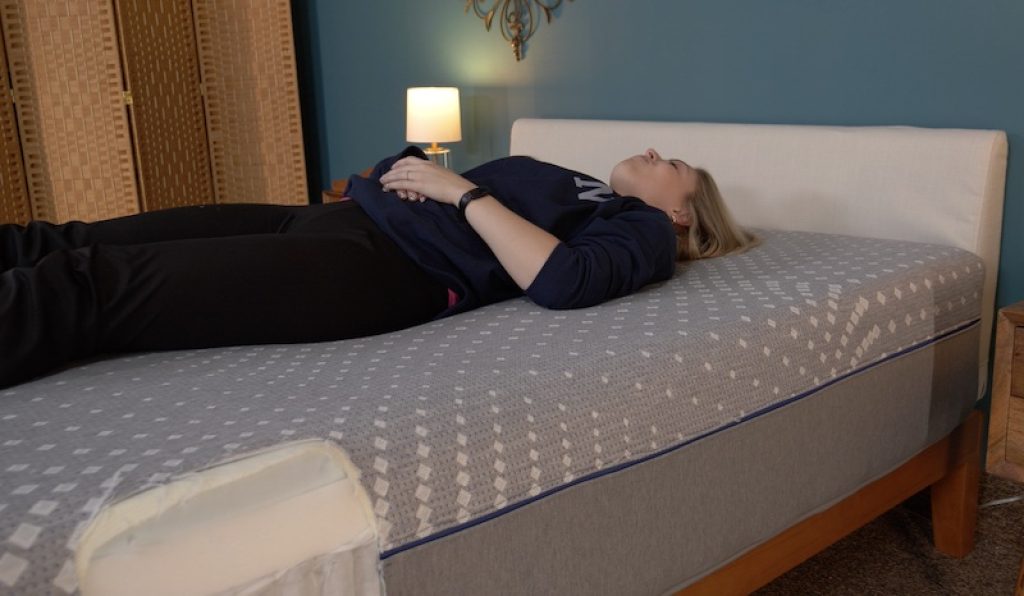
Type of Mattress
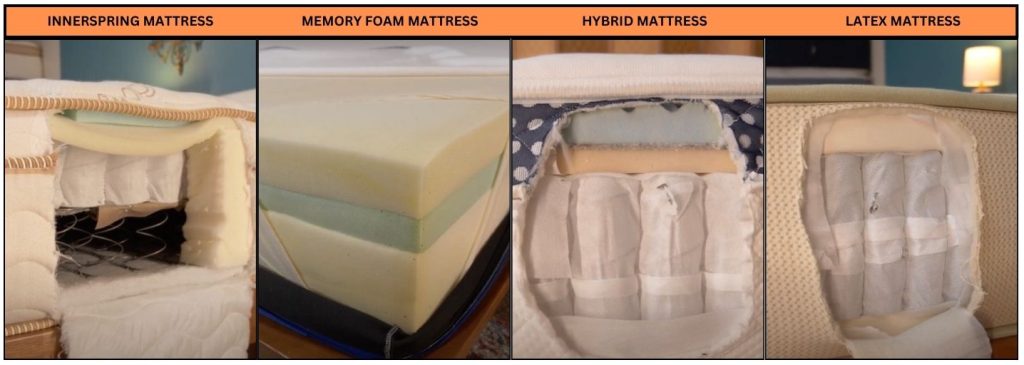
Memory Foam
Memory foam is a soft, cushiony material that holds its shape even after you put weight on it, hence the term “memory.” When you lie down on a mattress made out of memory foam, it will conform to the shape of your body and keep that shape during the night.
This is typically a great mattress choice for herniated discs as long as it’s high-quality and made by a reputable company. Memory foam in cheap mattresses wears out faster, so it’s important to choose a brand that is known for durability and long-lasting comfort.
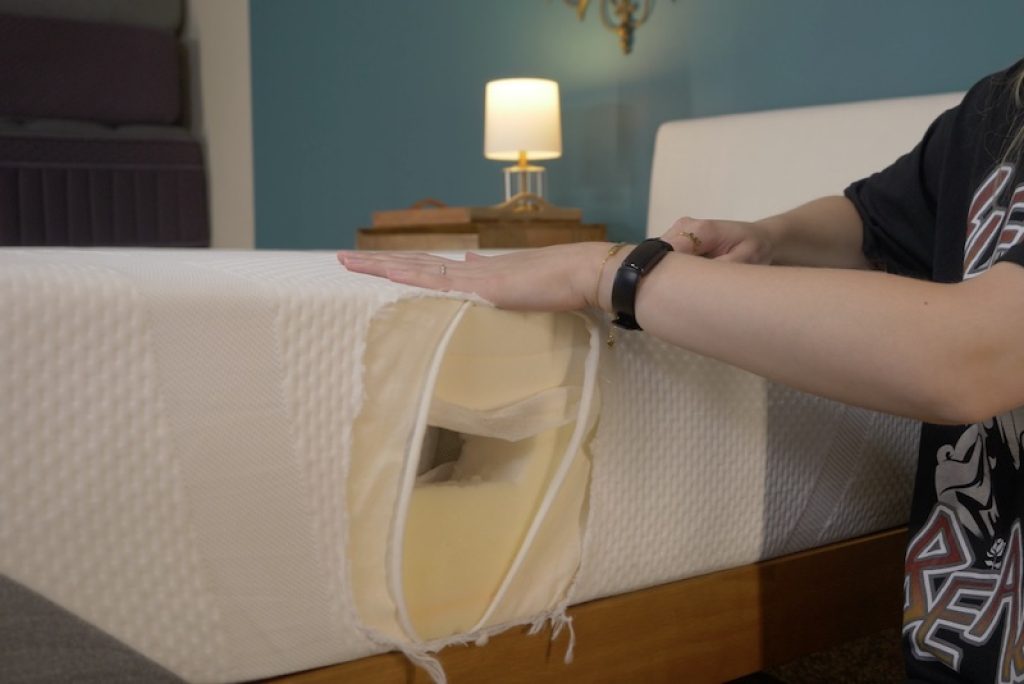
Explore our picks for the best memory foam mattresses.
Hybrid
Hybrid mattresses combine an innerspring (coil) base with a memory foam or latex top layer. This type of bed is another good choice because they tend to provide the ideal blend of pressure relief and support. That being said, hybrids usually come at a higher price point.
Innerspring
Innerspring mattresses can have a harder time delivering on the needs for this issue. First of all, they don’t tend to hold their shape over the years if the bed doesn’t have high-quality construction, so some people can expect uncomfortable sagging.
Second, most coils don’t allow for even weight distribution. Different parts of our bodies have varying density levels.
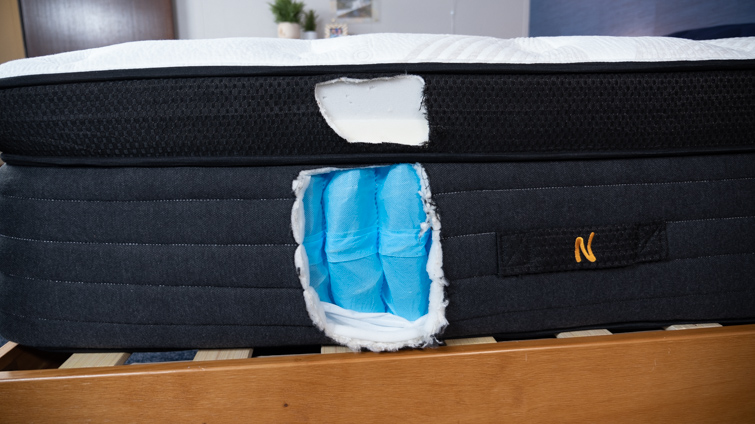
If you lie down on a coil mattress that isn’t “zoned” to accommodate your shoulders and torso, you will likely feel it in your back.
Latex
Latex beds can offer nice cushioning like memory foam, but instead of a synthetic production process, natural latex is made from the sap of a rubber tree. There’s also synthetic latex, which is a petroleum-based product. Research shows that this material could be beneficial for healing.4
Latex is also very responsive, which can make it easier for people with herniated discs to reposition on the bed.
Sleeping Position
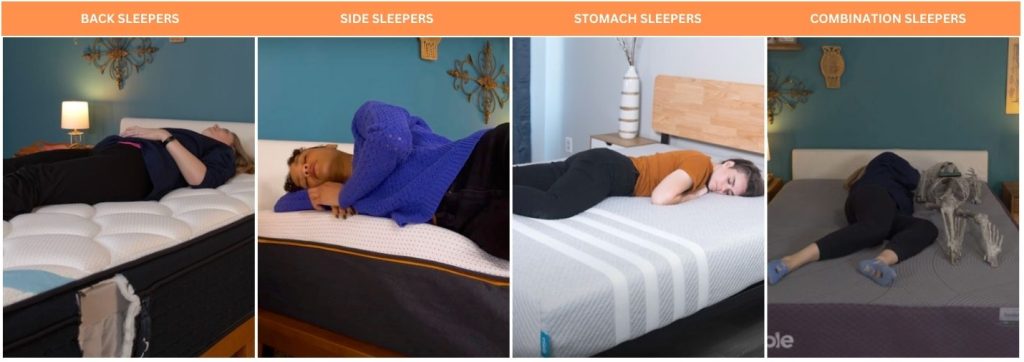
Your sleeping position can play a large role in alleviating the pain from herniated discs.
Sleeping on your back puts the least amount of pressure on your spine, and this could help alleviate pain from herniated discs.5 So, if you sleep on your back, continue to do so, and look for a supportive mattress with medium firmness as this will help keep your spine aligned.
Stomach and side sleepers should look for a mattress that won’t allow their hips to sag down in the mattress as this will help keep their spine neutral, though side sleepers may want to avoid a mattress that is too firm as this could cause pressure to build up on the hip and shoulder.
Weight/Body Type of Sleepers
Having a heavier body can already cause additional pressure and pain on herniated discs. Therefore, these people will want to find a bed that offers plenty of support. If heavyweight people push through a mattress’s layers too quickly because their bed doesn’t offer enough support, their spine can be put in an awkward position, which may exacerbate the pain from herniated discs.
Browse our picks for the Best Beds for Heavy People.
Lightweight people often benefit from softer mattresses more than their heavier counterparts as this can help keep pressure from building up. However, when it comes to buying a mattress for herniated discs, lighter sleepers will want to make sure that it is supportive enough to keep their spines aligned.
Pressure Relief
When it comes to choosing the right type of bed for pressure relief, we’ve found that memory foam mattresses often perform best. You need something that cradles the heavy parts of your body while also providing ample support. Memory foam is designed to contour all of your curves, making it a great material for pressure relief.
Each of our mattress’s pressure relief technology is put to the test using pressure maps. The pressure maps will pick up if there’s any buildup. Reds and yellows on the map’s reading indicate there’s pressure, whereas blues and greens indicate little to no pressure.
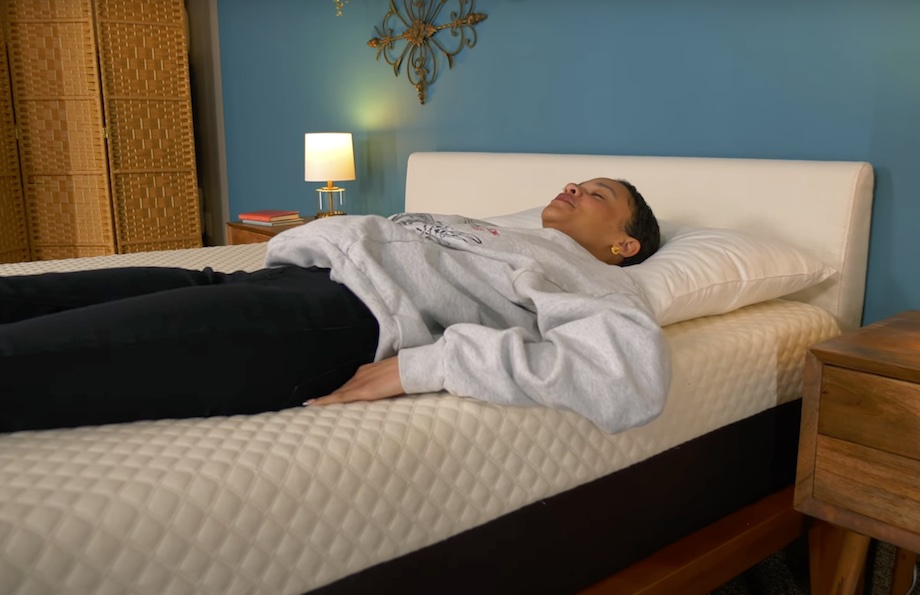
Looking for more relief? Explore our picks for the Best Mattress for Pressure Relief.
Edge Support

When you are sleeping on a bed with good edge support, you can utilize the entire bed without worrying about falling off the edge. This makes it beneficial for couples and those who just prefer to sleep closer to the outside of the bed.
If you have herniated discs, it may be even more important because the jerking motion that can take place when the edge of the bed gives out could make the pain worse. Edge support is usually provided by putting reinforced coils or high-density foam around the outside.
Our team tests this by sitting and lying at the edge for a minute each. If our testers don’t notice much sagging or slipping in their tests, that tells us the bed has sturdy edges.
Seniors looking for a supportive mattress should check out our Best Mattresses for Seniors.
Cooling
Have you ever noticed that when you’re in pain, you tend to feel hotter? If you sleep on a mattress that doesn’t allow for any airflow, your already-heated body is going to feel even more uncomfortable.
Memory foam is not known for being a cool material, mostly because the contouring traps body heat. We recommend looking for a memory foam mattress with either gel or copper infusions, which draw heat away from the body.
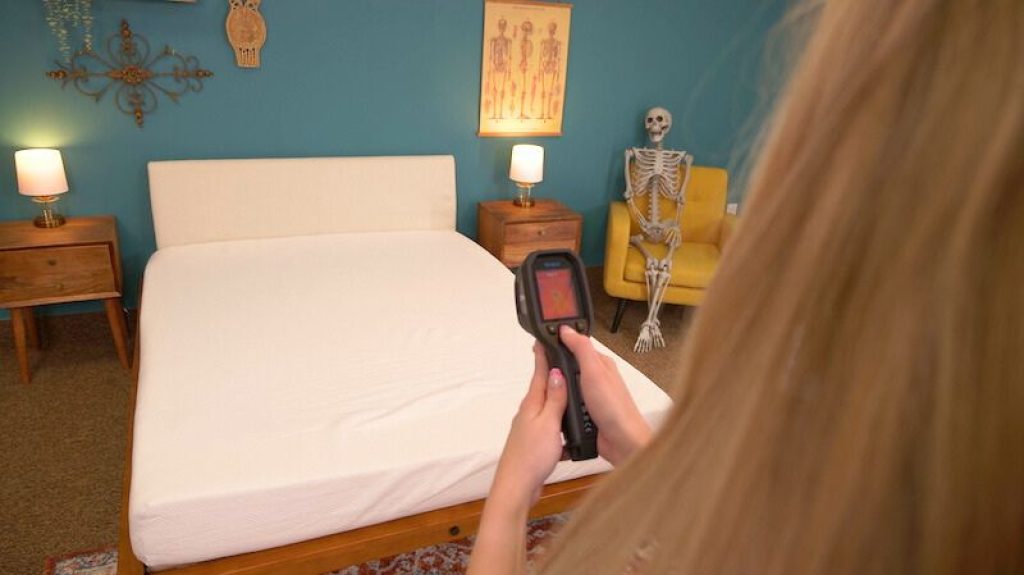
There are also some brands that offer something called “open cell” construction that have pockets of air that get released when you put weight on them.
Hybrid and innerspring beds get extra airflow from their coil units, and latex beds are good for cooling because latex is a temperature-neutral material.
As part of our cooling testing, we use a heat gun to see how the bed’s temperature regulation works in real-time. We take an initial temperature reading, then we do another reading after lying on the bed for 5 minutes, followed by a third reading after lying on the bed for 10 minutes. If the bed doesn’t heat up by more than 15 degrees, that’s a good cooling bed.
Find Out More: Best Cooling Mattresses.
Motion Isolation
When you’re in pain because of herniated discs, you don’t want movement from your partner or pet to compound your issues. Therefore, if you sleep with another person or even a dog, you will want a bed that doesn’t transfer the motion that is made from their movement from their side of the bed to theirs. Memory foam mattresses are typically a solid choice for isolating motion, and these beds may be a good choice for those with herniated discs.
We test for motion isolation using a seismograph app, which can pick up if there’s movement transfer across the bed while our tester moves around. If we see a lot of high spikes on the reading, that tells us the bed doesn’t absorb motion well.
Looking to upgrade your mattress? Check out our Best Luxury Mattresses.
Sex
Herniated discs may make sex difficult because the movements involved with intercourse may aggravate your pain. Your doctor and medical professional may recommend that you refrain from sex when you have herniated discs, but if you are cleared by your doctor, you will likely want to find a bed that is responsive and bouncy.
Responsiveness is often associated with latex or latex hybrids. This is because these beds quickly regain their shape. Mattresses for sex have good bounce, allowing you to reposition more easily.
Budget
Considering the amount of time that we spend in bed, and the impact that quality sleep has on our overall health, purchasing a mattress that meets our needs is extremely important. However, considering that they can also be a major expenditure, doing the research beforehand can help ensure that we are getting the best mattress for the money.
This is particularly important if you have a medical condition that could be made worse by a mattress that isn’t providing enough support. In this instance, you will want to try to get the best possible bed that your budget allows.
What Causes Herniated Discs?
Picture your spine. We’re all familiar with the line of vertebrae that goes from our skull to our lower back. There’s a space between each of these vertebrae, and within that space are discs. Their purpose is to provide mobility. They function like ball bearings.
The discs themselves are fibrous with layers of ligaments that protect a center core of gel-like fluid. If you picture the rings of a tree, that’s what a section of a spinal disc looks like. The annulus makes up the exterior part, and the soft center is called the nucleus.1
A herniation occurs when those fibers get damaged or degenerate. The inner fluid begins to push outward, distorting the shape of the disc. The result is the disc either bulges or ruptures, depending on how damaged and degenerated the fibers become.
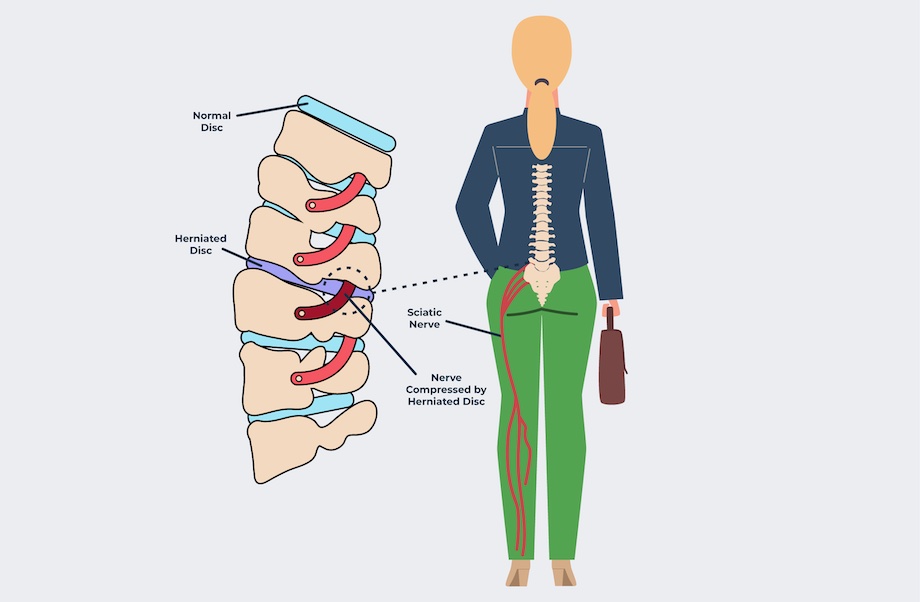
Types of Herniated Discs and Symptoms
Depending on the type of spinal disc herniation you have, the symptoms vary:
Contained Herniation (Protrusion)
A contained herniation usually happens in the first two stages before the gel-like material leaks into the spinal canal, which typically happens in the third and fourth stages. This means the jelly center is still contained within the outer wall of the lumbar disc. Besides lower back pain, patients may experience symptoms such as arm and leg pain, numbness, tingling, and weakness1.
Non-Contained Herniation (Disc Extrusion)
A non-contained herniation typically causes more severe back pain. What happens in this stage is that the gel-like material breaks through the outer wall of the intervertebral disc. The material leaks into the spinal canal and causes many painful and uncomfortable symptoms. This is why non-contained herniation is often called ruptured discs as well. The symptoms may include tingling, numbness, and pain that can be severe and long-lasting1.
Sequestered Herniation
Sequestered herniations happen if a patient doesn’t treat non-contained herniations. What happens is that the discs beak due to the compressor, which then results in severe pain and even loss of mobility if patients ignore the symptoms long enough. Those who deal with chronic back pain may be more likely to ignore symptoms of sequestered herniation, although consulting a doctor is critical1.
How Can a Mattress Help with a Herniated Disc?
“A mattress can either make a herniated disc feel worse or help ease the pain. If it’s too soft, it might not support your spine enough, putting more pressure on the sore spot. But if it’s firm enough to keep your spine aligned, it can actually relieve some of that discomfort by taking the pressure off the herniated disc.”
Dr. Raj Dasgupta
Although herniated discs can happen in any part of the spine, they typically happen in the lower spine.6 Some people may not even know that they have a herniated disc, but others can experience pain from the buttocks to the foot.
Medical intervention isn’t usually required, but if you are concerned about your symptoms, you should always consult a medical professional.
Fortunately, these back issues can usually be treated with at-home remedies, including using an appropriate mattress.
- Those who have lower back herniated discs should look for a mattress that is supportive to keep their spine neutral and their hips from sagging.7 Find mattresses that won’t sag here.
- Memory foam mattresses offer excellent pressure-relieving properties. If you have herniated discs in your upper back, these kinds of mattresses may bring relief to the pain around your neck and shoulders.
- Responsive mattresses, such as beds made from latex, can make it more comfortable to roll over, and this can ease herniate disc pain that may happen from changing positions.
- Medium-firm beds are often recommended for those with herniated discs.3 Finding a bed with targeted support and a medium firmness may help with overall comfort.
Why You Need a Great Mattress if You Have Spinal Disc Herniation
We all deserve a great mattress, regardless of the medical issues we may have. However, if you have any spinal problems, sleeping on the right mattress makes a big difference.
You need to keep your spine in proper alignment, and if you have a poor-quality mattress or one that is too soft or too firm, it will push your back out of its natural position.
Conversely, a good-quality mattress will have an ideal blend of pressure-point relief and support. Pressure relief is a mattress’ ability to cradle or cushion the denser parts of your body to keep you comfortable and reduce pressure build-up.
Support, on the other hand, refers to the bed’s ability to keep your body lifted. For example, even though you want to feel a soft surface that relieves pressure when you lie down, you don’t want to sink too deeply into the surface of the bed. That’s where support comes in.
A great mattress will provide the perfect balance of both of these factors. Find the overall best mattresses here.
What Is the Best Sleeping Position for a Herniated Disc?
A slipped disc is a term often used to describe a herniation, though it’s technically a misnomer because the disc isn’t actually slipping. Rather, it’s being pushed out of place due to being misshapen.
Now that we’ve gotten that out of the way, we can discuss the best sleeping position for a herniated disc. The answer to this question lies in where in your vertebral column the herniation has expressed itself: neck, thoracic, or lumbar.
Here are general guidelines for each sleeping position:
Back Sleeping
Sleeping on your back is usually the best choice, though there are a couple of caveats. If your disc herniation is in your neck area, you should focus on which pillow you use. Ideally, a cervical pillow with a center opening to let your head sink while supporting your neck is best.
Also, when you sleep on your back and you have a herniated disc, you’ll probably feel most comfortable with a pillow underneath your knees.
Side Sleeping
As long as you have the right mattress, side sleeping can be a fantastic choice, especially if you have a herniated lumbar disc. You can try sleeping with a pillow between your knees to ensure that your spine doesn’t twist during the night.
You can also try a cervical pillow regardless of where your herniation is located. Keeping your cervical spine in place can help to make sure the rest of your back stays in alignment.
Explore our picks for the best mattresses for side sleepers.
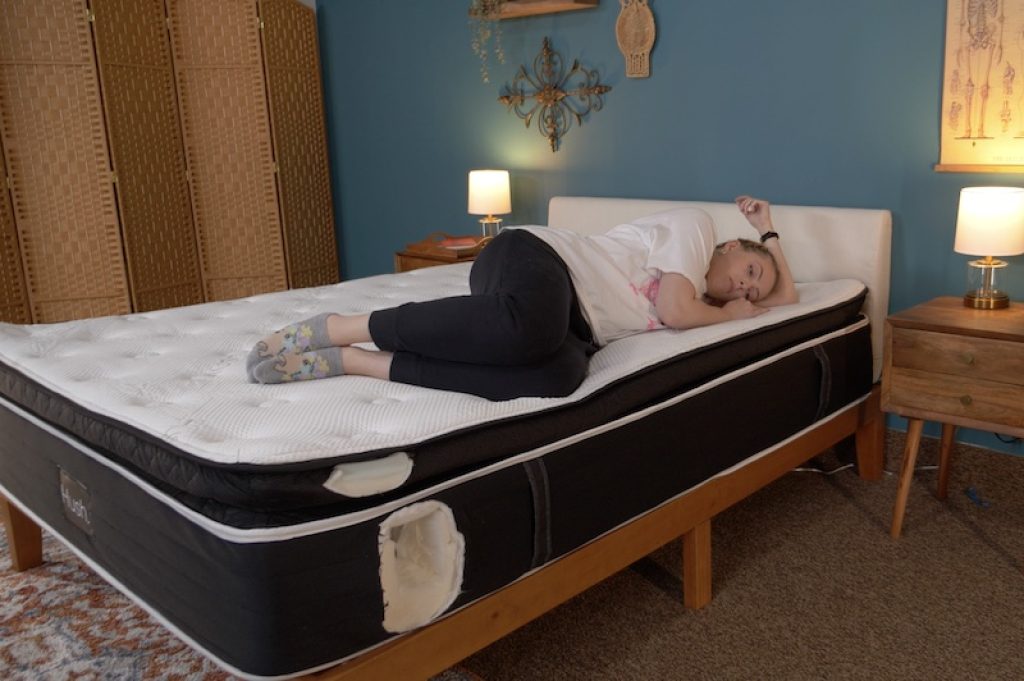
Combination Sleeping
Since movement can sometimes aggravate herniated discs, combination sleepers will need to change positions carefully, which is why a more responsive bed is helpful in this case.
Also, if one of your go-to positions is stomach sleeping, you may want to find an alternative. This is because when you sleep on your stomach, your hips can sink into the bed and cause your spine to curve. When you have herniated discs, this can become a painful situation.
Stomach Sleeping
This position is not typically recommended because it can force the hips down and cause your back to arch in an uncomfortable way. If you insist on stomach sleeping, you can place a pillow under your pelvis and at your knees. For your head pillow, choose something very thin or opt for nothing at all.
Tips for Better Sleeping with a Herniated Disc
- Sleep on your back or side, and avoid sleeping on your stomach when possible.8
- Back sleepers can put a rolled-up towel under their lower back.8
- Side sleepers may want to use a wedge pillow below their legs.8
- Try sleeping in the fetal position to eliminate pressure.9
Mattress for Herniated Disc FAQs
Can a bad mattress cause a herniated disc?
A bad mattress won’t cause a disc to herniate, but it can prolong or prevent the healing process. Sleeping on the wrong mattress can also accelerate the degeneration process, so even though it won’t be responsible for the actual herniation, it can be a contributing factor.
How do you sleep with a herniated disc in your neck?
When you have a herniated disc in this area, the most important thing to keep in mind is neck support. This means sleeping on a pillow that is slightly higher under your neck than your head. Using cervical pillows that dip in the center and have a gentle, rounded ridge at the base of your skull can be very helpful.
Want to see more? Check out our complete guide for the best pillows for neck pain.
What is degenerative disc disease?
Degenerative disc disease (DDD) is not technically a disease.10 Rather, it’s the long-term degeneration that happens to your spine as you age. However, age is not the only thing that causes this, and just because we get older, it doesn’t mean we have to experience DDD.
Factors that can cause discs to start wearing down include injuries, drying out of discs with age, and tears that result from sports and daily activities.11 A nutrient-rich diet, moderate exercise, and avoiding obesity can help support your overall health and may help slow or prevent degenerative disc disease.
Can this condition cause sleep apnea?
While excess soft tissue in the mouth and throat often is the culprit behind obstructive sleep apnea, the less common central sleep apnea (CSA) may originate in spinal trauma or injury, which can include herniated discs, though this is very rare.12 When a spinal disc shifts out of place because of stress or acute injury, it can impinge nearby spinal nerves resulting in a disconnect between the muscles you use to breathe and the brain.
Interested in exploring further? Learn more in our best mattress for sleep apnea guide.
What type of mattress is best for a herniated disc?
Memory foam, hybrid, and latex mattresses should be best for struggling with herniated discs. These beds are good at contouring the body and relieving pressure in the most critical areas, including the lower back. On top of that, some models even have zoned support that further enhances the contouring in the lower back.
How should I sleep with a severely herniated disc?
The best way to sleep if you have a herniated disc is on your back. You can even add a small pillow under your knees if you need more relief. This way, you’re less likely to feel as much pain because the nerves aren’t under so much pressure. Side sleeping is also an option, though we recommend avoiding stomach sleeping if possible.
Is sleeping on a hard surface good for a herniated disc?
Sleeping on a surface that’s too hard, like the floor, may worsen the symptoms as it offers no contouring. This can put too much pressure on the lower back, so sticking to medium and medium-firm surfaces should be better. These beds usually offer a good balance of pressure relief and support, both of which are crucial for those with a herniated disc.
Is a soft or firm mattress better for a herniated disc?
For most people with herniated discs, a medium-firm mattress will likely serve them best.3 This firmness level should provide adequate back support for most sleepers to help keep the spine aligned while still offering pressure relief to the joints.
Although sleeping on a soft bed can be comfortable and cozy, it may cause more harm than good when dealing with herniated discs. A soft mattress may not offer enough support to keep your spine properly aligned, which could put more pressure and strain on your herniated discs.
Compare Prices of Our Top Rated Mattresses for Herniated Discs
| Mattress | Best For | Price (Queen Size) | Review |
| Nectar | Overall | $1,099 | Nectar Mattress Review |
| Helix Midnight | Hybrid | $1,199 | Helix Midnight Mattress Review |
| Saatva Rx | Side Sleepers | $3,295 | Saatva Rx Mattress Review |
| WinkBed | Low Back Pain | $1,799 | Winkbed Mattress Review |
| Nolah Signature | Pressure Relief | $1,599 | Nolah Signature Mattress Review |
| Bear Elite Hybrid | Back Sleepers | $2,305 | Bear Elite Hybrid Mattress Review |
| Plank Firm Luxe | Stomach Sleepers | $1,149 | Plank Firm Luxe Mattress Review |
| Birch Natural | Organic | $1,799 | Birch Mattress Review |
Medical Disclaimer: If you have or are concerned that you may have a herniated disc, always work closely with your healthcare provider regarding appropriate lifestyle changes, including sleep.

Julia Forbes
Sleep Advisor Mattress Tester
About Author
Julia is a product tester at Sleep Advisor, specializing in testing out mattresses and sleep accessories – she’s in the right line of work, because she loves to sleep.
Stomach Sleeper
Education & Credentials
- Certified Sleep Science Coach
References:
- Dydyk, Alexander M., Massa, Ruben Ngnitewe., Mesfin, Fassil B. “Disc Herniation”. National Library of Medicine. 2024.
- Caggiari, Gianfilippo., et. al. “What type of mattress should be chosen to avoid back pain and improve sleep quality? Review of the literature”. National Library of Medicine. 2021.
- “Herniated Discs FAQs”. Mayo Clinic. Webpage accessed July 6, 2024.
- Guerra, Nayrim Brizuela., et. al. “Biomedical applications of natural rubber latex from the rubber tree Hevea brasiliensis”. National Library of Medicine. 2021.
- “Best Sleeping Positions for Pain”. Cleveland Clinic. Webpage accessed July 6, 2024.
- “Herniated Disk”. Mayo Clinic. Webpage accessed July 6, 2024.
- “Herniated Disc Disorders”. Penn Medicine. Webpage accessed July 25, 2024.
- “Sleeping positions that reduce back pain”. Mayo Clinic. Webpage accessed July 25, 2023.
- “How to Get Better Sleep with Sciatica Pain”. Cleveland Clinic. Webpage accessed July 25, 2023.
- Kos, Natasa., Gradisnik, Lidija., Velnar, Tomaz. “A Brief Review of the Degenerative Intervertebral Disc Disease”. National Library of Medicine. 2019.
- “Degenerative Disc Disease”. Arthritis Foundation. Webpage accessed May 16, 2024.
- Alexander, Tyler D., et. al. “Sleep apnea and unilateral upper and lower extremity allodynia as a result of a large thoracic disc herniation: a case report”. Sleep Science and Practice. 2021.

